This is not just another book
about gardening. A glance at the shelves of book shops,
charity shops, or public libraries shows that no further
volumes are needed. In any case, this author is totally
unqualified to offer any shred of advice on the subject. If
you wish to know when to prune your roses; how to prick out
your seedlings; the best way to scarify your lawn; or
whether or not to fumigate your greenhouse – please refer
elsewhere.
I have simply attempted to outline the story of gardening in
Tring and district from the late seventeenth century to the
present day. It has to be said that the town is not
especially known for any particular aspect of horticulture,
but in spite of this Tring gardening has a varied history.
This may be due to the fact that the very large private
estates in the vicinity had beautiful gardens, parks, and
walled areas. At the same time, allotment holders and
cottage gardeners added to the scene. Two world wars spurred
many to take up a spade or fork. In contrast, some
individuals in Tring have pursued their specialist gardening
passions. In attempting to squeeze three hundred years of
history into one small book, it is inevitable that some
aspects of gardening may have been left out, and if this is
so I apologise.
My thanks go to the many people who have contributed
information, photographs, and reminiscences, without which
the book could not have been written. Special thanks go to
Peggy Bainbridge, Michael Bass, Mervyn Bone, Alec Clements,
Grace Duckworth, Roger Dye, Peter Fells, Jill Fowler, Joan
Gregory, Martin Hicks, Angela Lloyd, Heather Pratt, Shirley
Read, Ann Reed, Rodney Sims, Carol Willmore, the staff of
the Dacorum Heritage Store, and the NatWest Bank.
W.M.A.
October 2006
――――♦――――
CHAPTER 1
The Early Years
|
What was Paradise? but a Garden,
an Orchard of Trees and Herbs, full of
pleasure, and nothing there but delights.
William Lawson, 1656 |
Before the seventeenth century about gardens in Tring.
Ordinary people were so busy struggling to make a living and to
support their families that no time was left for leisurely pursuits.
Most local effort went into farming the land, and any other
cultivation was solely for the purpose of growing vegetables.
Only the owners of large town houses or country estates could afford
the luxury of a garden, and so it was in Tring, as the first
reference to gardens of any sort is, unsurprisingly, those of
Tring Park House. The Manor of Tring had been
bestowed by King Charles II on Henry Guy, one of his finance
ministers. Access to the Treasury funds was tempting, and it
is said that Henry Guy appropriated money to build himself a
splendid new house surrounded by parkland and beautiful gardens.
A visitor at the time described Henry’s gardens as “of unusual
form and beauty”, but no other account survives.
|
 |
|
Charles Bridgeman (1690-1738)
English garden designer |
In 1702 the estate passed to Sir William Gore, and it was his son
who commissioned the services of Charles Bridgeman, the leading
landscape garden designer of the day. Working in conjunction
with the architect James Gibbs, Bridgeman created a fashionable
Baroque layout, covering 300 acres of park, 20 of which were given
over to gardens. An engraving of 1739 shows all the design
features, which included parterres, gravel gardens, a very large
straight–sided canal, softly–moulded lawns, and a formal woodland
with rides. Beyond all this, terraced slopes and extensive
avenues of trees led to an elaborate decorative building. To
the east of the house lay a bowling green, and an extensive walled
kitchen garden.
Just how much of Bridgeman’s ideas were carried out is not known,
but certainly enough for a guest at the time to observe admiringly:
“There
are 20 acres of gardens all full of fine slopes, with a canal
between and a Green House of eleven windows to front it; the House
is in the midst of the Park which is full of easy hills covered with
Beech and Oak trees, in which a canal of 110 feet broad is going to
be made to front the House; and the Park has 300 head of deer, and
the Gardens are so rich that there are always nine men and four boys
to keep them”.
Fashions change, and as the eighteenth century progressed the taste
for formal layouts with geometric lines and straight vistas fell out
of favour. The demand was for less enclosed spaces with more
views to the adjoining parkland. Large areas of water were
considered desirable, and streams and rivers were diverted or dammed
to provide natural–looking lakes. Sir Drummond Smith, the next
owner of Tring Park, followed the trend and swept away much of the
old design. For some reason the 300–metre avenue, running
north to south from the house, was allowed to remain and survives to
this day, as do both the obelisk (Nell Gwyn’s Monument) and the
portico of the summerhouse.
Britain’s increasing prosperity at this time meant that more local
gentry and London merchants were able to acquire land and build
large houses surrounded by gardens and parks. In 1764, John
Seare, the owner of The Grove at Tring, is known to have paid
Nathaniel Richmond, then a leading market gardener, £31 for
supplying plants from his London nursery. Two years later, the
property is shown on a map of Hertfordshire, but virtually nothing
is known about this fine house or its surroundings for, by the
beginning of the next century, all had disappeared. Four other
large country houses near Tring have gardens set in the natural
landscape, with little formal planting. These are the
late–Georgian properties Stocks House at Aldbury, and
Drayton Manor to the west of the town; and the Victorian houses
Pendley Manor, and Champneys at Wigginton.
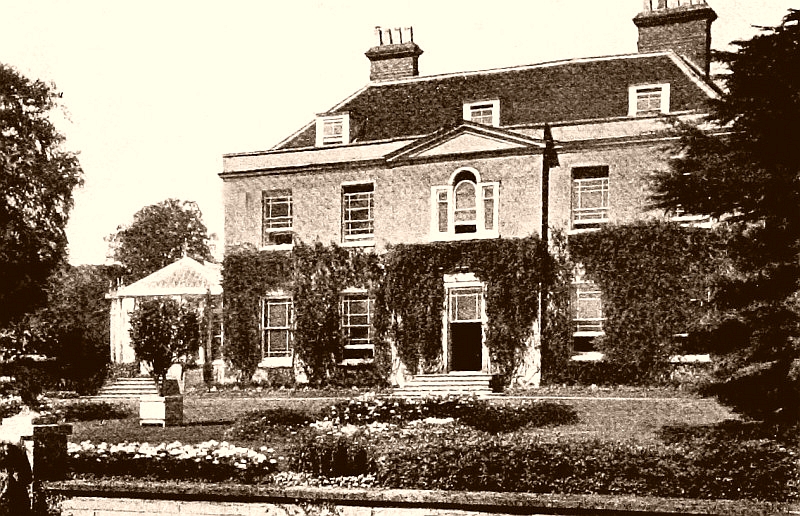
Stocks House, Aldbury, c.1903
When the successful novelist Mrs Humphry Ward and her husband moved
into Stocks in 1892 she enthusiastically described the house
and gardens to her father, but assured him “they are not grand in
any way”. However the account that followed describes a
layout far from modest, as she says it had “old–walled and
yew–hedged gardens, a small bit (i.e. 300 acres) of beautiful park,
and an avenue of limes like a cathedral aisle”. At a later
date T. H. Mawson, a fashionable garden designer of the time, worked
at Stocks, but many of his ideas were not implemented due to
cost. A cricket pitch was laid out for the use of the Wards’
son and his friends.
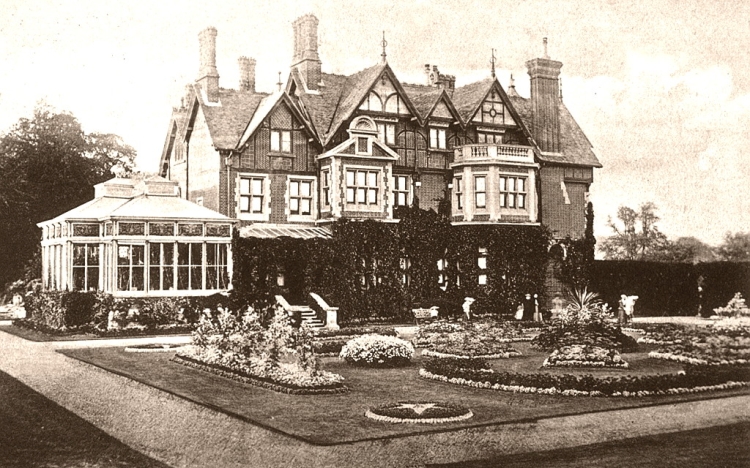
A late Victorian/Edwardian view of Pendley Manor
At Pendley some of the original planting is still to be seen,
with beech–lined drives and specimen trees including sweet chestnut,
Turkey oak, Atlas cedar, and Wellingtonia. Likewise at
Champneys many fine trees planted in the 1880s are now in the
full glory of their maturity. In the parks of both estates
were tennis courts, croquet lawns, and cricket pitches. In
properties of this type, the walled kitchen gardens contained large
areas under glass which included vineries and peach houses.
The kitchen garden at Drayton Manor enjoys a particularly
beautiful situation, with a backdrop of beech woods on the Chiltern
Hills. Although now crossed by the A41, Tring Park
still remains a enjoyable area in which to walk and appreciate the
landscape features. The grounds of both the hotel at
Pendley Manor and the health spa at Champneys can be
enjoyed by visiting guests. The old walled garden at
Champneys is given over to organic production of both vegetables
and fruit for use in the kitchen.
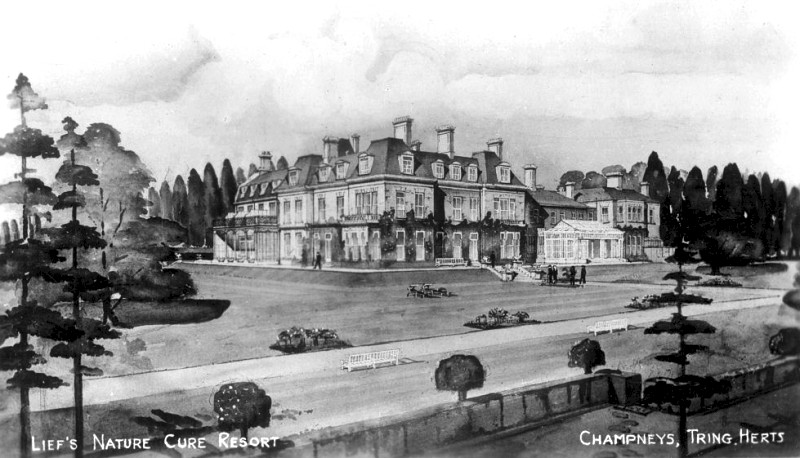
Champneys near Tring
(postcard)
――――♦――――
CHAPTER 2
The Horticultural Society
|
What a desolate place would be a world
without
flowers! It would be a face without a smile,
a feast without a welcome.
Clara Lucas Balfour, 1848 |
Tring Agricultural Association was formed in 1840 with aims of the
‘promotion of agriculture and horticulture and to reward industrious
labourers’. For nearly thirty years the Association carried
out its stated objectives, and the event mainly involved landowners
and farmers who gathered at the annual show on a site near Tring
Station. This was a regular date in the calendar of the
district, and was always well supported and well run.
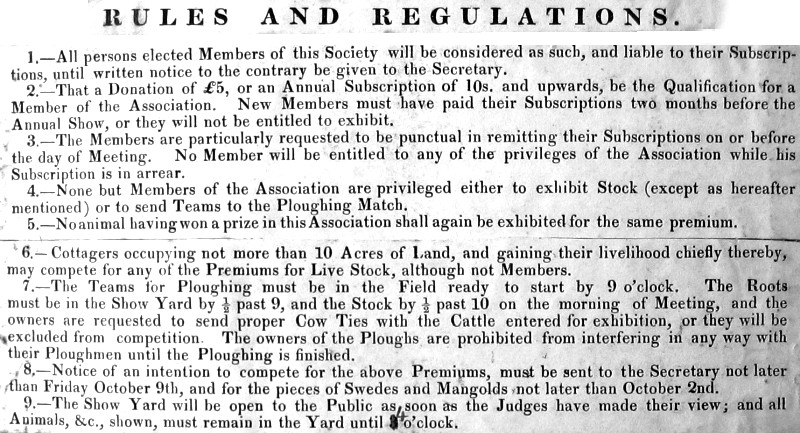
Tring Agricultural Association rules, c.1855
In 1868 an innovation was introduced when Dr Thomas Barnes, at that
time living with his family in Tring Park mansion, sponsored
a class for those in less affluent circumstances. Prizes were
offered for the neatest cottage and garden within three miles of the
Market House, the rent of which did not exceed £7 per annum.
From this small beginning, the seed was sown (forgive the pun) for
the foundation of Tring’s Horticultural Society.
As the years passed it was realised that the show would attract more
visitors if a site nearer to the town centre could be found.
By the time Rothschilds arrived in 1874, the show had steadily grown
in size and reputation, and it was then logical that it should be
held on their land. The following year, the Flower Show
classes relocated to Dawe’s Park (an area south of Park Road), and
fifteen years later the main Agricultural Show moved to the Park.
The Rothschild family’s benevolent attitude towards Tring was never
more evident than on Show days, when everyone was allowed to wander
at will through the Park; the gardens (see Chapter 4)
were open to the public; and famous military bands provided
entertainment. Nothing is so redolent of the fin de siècle
era as accounts written at the time when, of course, the sun always
shone from a cloudless sky; ladies wore gigantic flowery hats, and
twirled parasols; gentlemen sported blazers and boaters; all to the
accompaniment of selections of music from The Merry Widow,
Gilbert & Sullivan, and other period pieces.
In 1892 the Flower Show was renamed the Tring Horticultural &
Cottage Garden Show, and by the turn of the century the new event
was attracting around 500 people, who were rewarded by splendid
displays of flowers and vegetables set out in large marquees
decorated with ferns and palms from the conservatories of Tring
Park and Pendley Manor. As well as prizes for
garden produce, classes included bread, pastry, cooked vegetables,
and straw plait, and awards were presented for the best–kept
allotments in Tring and the surrounding villages.
“COTTAGE GARDENS SHOW: the Committee of the Tring Working Men’s
Club have just issued the preliminary notice of the annual show of
flowers, fruit, and vegetables, &c. This show has undoubtedly
given a great impetus to cottage gardening in Tring, and is now
quite an institution of the town. In the matter of allotments
Tring is singularly fortunate, as, owing to the liberality of lord
Rothschild and Mr. J. G. Williams, any man who has the leisure and
the inclination to cultivate a plot of ground can obtain the
necessary land at a mere nominal rent.
Recognising the importance of an allotment to a working man, the
Committee of the Club devote special attention to this particular
form of gardening. The allotments are grouped in six classes
for the purposes of the competition, and three prizes are offered in
each class. In addition to these prizes, this year Mr. George
Parrott, coachbuilder, offers a wheelbarrow as a champion prize for
the best allotment entered for the competition.”
Bucks Herald, 18th April 1896
The annual Cottage Garden Show encouraged club members to cultivate
allotments where, as plot-holders, they could acquire new knowledge
and skills, derive a sense of achievement from growing their own
seasonal produce, save on the household budget, and gain social
interaction with a community of like-minded people.
Obtaining fertiliser was not a problem for gardeners in the days of
horse power, and many cottagers believed that great results could
also be achieved by utilising the contents of the privy bucket.
They supported their argument by displaying excellent crops of
vegetables. Especially successful were tomatoes and cucumbers
which had the added advantage of being self–set, as it was well
known that pips from both plants pass undamaged through the human
digestive system. (Some did admit that application of this
form of manure was not exactly pleasant, but many householders owned
a special privy bucket which was designed with a long handle to
avoid slopping the contents.)
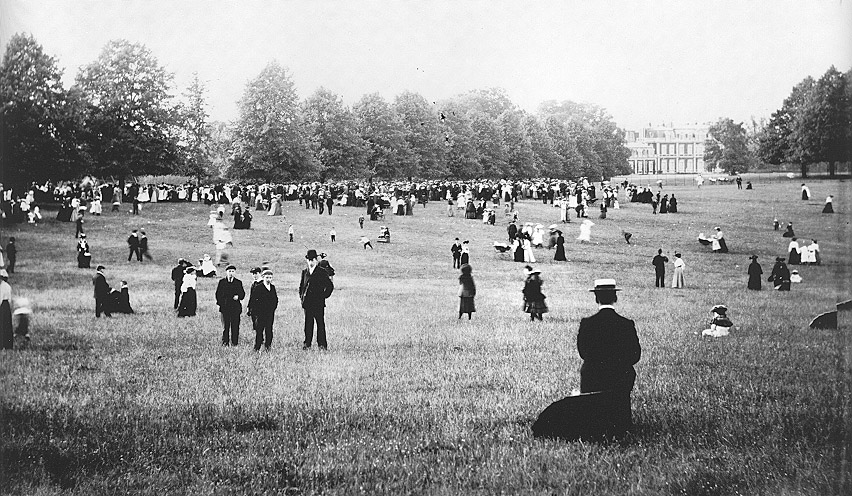
Tring Flower Show day, 1904
On Horticultural Show days Rothschild hospitality was again
generous, and visitors enjoyed a lavish tea under the trees, whilst
listening to selections played by the Tring Brass Band. This
was followed by athletic sports, giving the younger people of the
district an opportunity to show their prowess. Their efforts
were well rewarded as the prizes, often presented by Lady Rothschild
in person, were substantial, and the winner could expect a useful or
decorative item with his or her name engraved on an attached brass
plate. The prizes included canteens of cutlery, clocks,
tables, cut glass, suitcases, and inkstands.
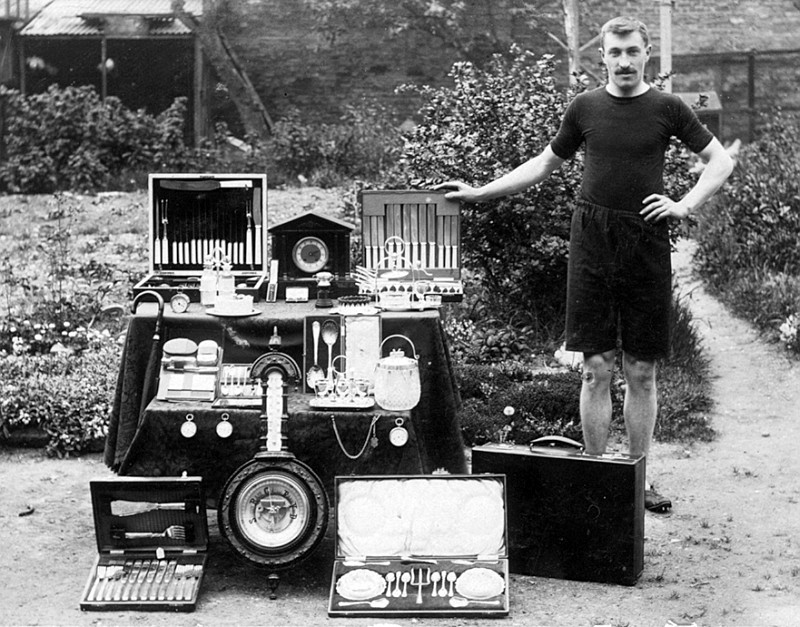
Richard Wright of Langden Street, with trophies
won for athletics on
Flower Show day
When the first war broke out, most horticultural effort had to be
concentrated on vegetable–growing, and flower shows in Tring became
a fond memory. But in 1924 an inaugural meeting was held in
the Market Hall when a provisional committee of ten, chaired by John
Bly, proposed an open meeting to try and resurrect the society.
It rose like a phoenix, and soon
the shows of the pre–war years were again enjoyed. In the
second war, the Society continued in a limited way, encouraged by
the Ministry of Agriculture, Fisheries & Food. Now–famous
posters could be seen around the town, such as Dig for Victory
and On the Kitchen Front. People were encouraged to
switch on their radios early each morning and listen to gardening
tips. Advice was along the lines of “Garden peas that have
grown hard through lack of water or age can be put through a sieve
and made into excellent soup; Stew plums with no sugar, pulp, store
in hot clean bottles, and seal immediately; and Put down mothballs
as a deterrent for keeping away cabbage–white butterflies”.
The post–war years saw a large increase in membership, and shows,
now combined with fêtes, were held at different venues, including
Home Farm, Osmington School, and Christchurch Meadow.
Lectures were arranged in winter months, together with an annual
dinner and Harvest Supper. Several high–spots occurred during
this period, including the establishment of the popular Floral Art
section, and the broadcast from Tring of an edition of the
well–known radio programme Gardeners’ Question Time. A
panel of famous gardeners, chaired by radio personality Franklin
Engelman, attracted a capacity audience of 250 at Mortimer Hill
School. Around this time, the Society also entered a team in
the County Gardening Quiz held in different towns all over
Hertfordshire. Tring usually acquitted itself well; in 1968 it
lost by only half a point in the semi–final.
As the years passed, all the villages around Tring founded their own
horticultural societies and usually held one or more annual event,
often combined with a fête. Show days then were the highlight
of the village calendar, and potential exhibits would be carefully
nurtured and guarded. Enormous trouble was taken to match in
size and shape the number of vegetables stipulated for each class,
and these were washed in a little milk and the tops trimmed with
geometric precision. Early the next morning the whole lot
would be loaded carefully into a wheelbarrow and trundled down to
the village hall. No–one was much concerned that the prize
money was small – it was the award
of a precious red certificate that really counted.
The Aldbury Allotment & Cottage Garden Association mounted their
inaugural show in the Memorial Hall in August 1931. The fates
were not kind, and it transpired that this was decidedly not a good
year to chose for the first–ever show. A week before the
planned event a terrific hailstorm damaged much of the produce
prepared by hopeful exhibitors but, even so, 150 entries were on
display.
Wilstone’s society was founded immediately after the war in 1946.
The opening ceremony of the first show was performed by founder
member Dennis Noble, the international baritone, who for some years
made his home in the village. The 10th annual show and fête was
opened by local celebrity, Dorian Williams, and a record 520 entries
judged. On that occasion the weather was awful, with the wind
howling over the loudspeakers. These adverse conditions inspired a
Churchillian–type speech from Dorian, who commented “There is
nothing more English than the allotments in an English
village............ the constant fight against the weather to
organise these little shows is characteristic of the national spirit
of determination”. The 21st Show in 1967 was opened by actor
Wilfrid Bramble of Steptoe & Son fame, and the 25th Show by Melvyn
Hayes of It Ain’t Half Hot Mum. But times change and,
due to lack of support, the society was disbanded in 1986 when the
funds were transferred to the village–hall appeal. Other local
villages have managed to keep their shows alive, and these include
Wigginton Gardeners’ Association, Long Marston & Puttenham, and
Aston Clinton Horticultural Societies.
In the mid–eighties Tring Horticultural Society was still
flourishing with a membership of 645. All events were
well–supported and the Society added to its reputation by winning
first prize at Tring Carnival for its float “Gardening through the
Ages”. However, as the the new millennium approached it was
clear that the growing of vegetables and flowers for exhibition was
not the popular pastime it had been. Also, members were
reluctant to give time to serve on the committee, so the decision
had to be taken to wind up its affairs. Its end came in 2000,
much to the regret of many townsfolk who had always supported its
shows.
Despite the demise of the Society, garden enthusiasts in the town
can still pit their skills against each other. Tring Town
Councillors are asked to nominate attractive gardens in their wards,
and the entries are judged by a local celebrity. Challenge
cups are awarded each year for Best Garden; for the best Small
Garden (a cup presented by the late Trevor Marwood); and for best
garden in Eight Acres. The latter competition began in 1966
when the estate was newly–built, and the head of the firm of
architects who designed the development donated a challenge cup.
The following year the town Council established a new competition
for the best–kept garden by any tenant occupying a local authority
property in Tring. The first winner was Arthur Poulton of
Woodland Close who had only lived in his house for two years and had
inherited ‘a wilderness’ of a plot. He impressed the judges
with his split–level garden containing rockeries, greenhouse, garden
pool with picturesque rustic bridge, trellises, and wishing–well.
In recent years a new commercial venture for a flower show has been
tried in Tring at Pendley Manor. This is held in the four–acre
meadow at the rear of the hotel which is well prepared to receive
the professional exhibits. Flowers, plants, trees, cacti,
alpines, and bonsai are among the displays on show, as well as
stands selling water fountains, garden furniture, and arts and
crafts. The first event in 2003 was opened by television
gardening personality, Charlie Dimmock, who was on hand to answer
visitors’ questions on gardening problems.
――――♦――――
CHAPTER 3
MARKET GARDENS AND NURSERIES
|
Seedsmen reckon that their stock in trade
is not seeds at all – it’s optimism.
Geoff Hamilton (1936–1996) |
In the mid–Victorian period several families named Marcham lived and
worked at humdrum occupations in Tring. One of the more
enterprising was Joseph Marcham, whose job as a gardener led him to
start a small business in Akeman Street. By 1850 Joseph was
able to describe himself in the local trade directory as a ‘gardener
and seedsman’. (In the early days Joseph’s only rival was an
elderly lady, Anna Missenden, who traded in groceries and seeds in a
small shop in Frogmore Street.) Joseph’s business prospered
and after a few years he relocated to Brook Street and established a
nursery which he ran for over 40 years. In November 1882
The Tring Telegraph carried the following notice:
“Joseph Marcham begs to acknowledge his sincere thanks to
the Gentry of Tring and Neighbourhood for their kind and liberal
support for the last 42 years. He begs to say that he has
given up his Nursery Grounds to his nephew W. Rickett. The
Shop and Business will be carried on as usual at 63 Brook Street.”
The Marcham expertise was passed on for two further generations, and
Arthur Marcham was responsible in the Edwardian period for laying
out many of the gardens of newly–built properties in Tring.
His son, Henry, received a good grounding in the trade at his
grandfather’s nursery. While still a young man, he spread his
wings and secured a job as garden foreman to the Duke of Devonshire.
He then moved on to become rose–grower to Lord Northcliffe, and
travelled further afield, engaging in important landscape work at
Castle Konospicht in Bohemia. Then he was appointed
inspector of three gardens belonging to Baron Alphonse Rothschild in
Vienna, where he held a very responsible position controlling a
staff of 204. During the first World War, he and his wife were
classed by the Austrians as enemy aliens and spent weary years in
separate internment camps. After the war he returned to
England and ran his own nursery at Carshalton, succumbing to heart
disease at the age of 54.
At the beginning of the twentieth century there were two market
gardens at opposite ends of the town. On the eastern side
Albert Westwood laid out a nursery on Mortimer Hill, very near the
site of Joseph Marcham’s original premises. He sold some of
his produce at his florist’s shop at No.18 High Street.
Albert’s business was later taken over by Frank Westron, trading as
a nurseryman, seedsman, florist, fruit grower, and retailer.
He was well qualified to describe himself as an all–round
horticulturist, as he had been brought up with gardening in his
blood. Born in 1875 at Taplow Lodge on the Cliveden
estate near the River Thames, Frank was the son of the head
gardener. He came to Tring in the 1920s and rapidly
assimilated into the life of the town as a town councillor and
church sidesman. He died in 1960 and left a home–made will
which, after his wife’s death, bequeathed a very generous sum to
provide “a home for the old people of Tring who have resided
there for years”. Due to legal complications and other
problems, it was over thirty years before fifteen bungalows were
erected on a redundant site in Mortimer Hill owned by Tring
Charities. The development is named Westron Gardens in
his memory. When Frank retired, his business and shop were
taken over by John Stewart, and the market garden area is now the
site of Nursery Gardens.
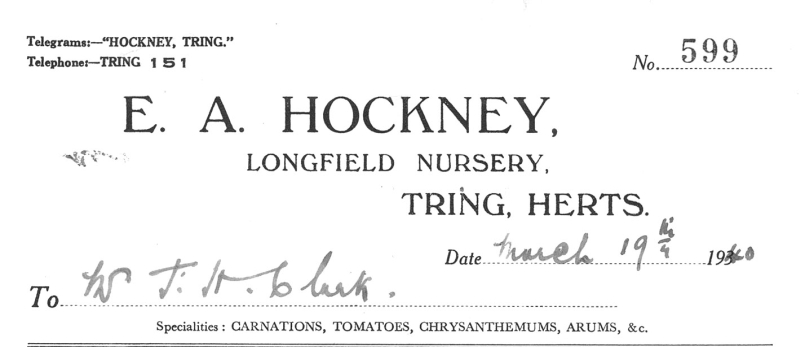
Edward Hockney’s and John Stewart’s
billheads
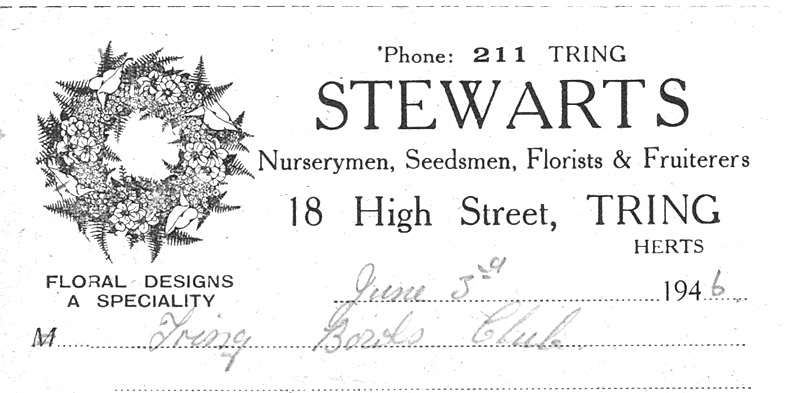
The other market garden was started by local builder, James Honour,
in 1897 in Longfield Road at the western end of the town. He
erected some fine large greenhouses, and from then until the nursery
was demolished, these were known locally as the ‘tomato houses’.
As the business grew the nursery diversified into other produce.
In the 1920s the business was acquired by the manager, Edward
Hockney, and later it passed to his son, Ted junior. To give a
flavour of those times at Hockneys, reproduced below is a brief
article that this author wrote for a Tring Local History Society
newsletter:
“A recent mention of the glasshouses in Longfield Road awakened
some old memories of the time when Ted Hockney junior, employed me
as a ‘worker’ during the school summer holidays. I quote the
word ‘worker’ as I cannot believe that a teenage girl who had never
so much as removed a weed from the garden, could have contributed in
any appreciable way to Ted’s business –
a budding Charlie Dimmock I was not. Looking back, I suspect
that he only gave me a job because he was a lifelong friend of my
mother, who had been born a few doors away in Longfield Road.
The Hockney family had always lived in the house adjoining the
business, and Mrs Hockney was remembered by older Tring residents as
a rather grand lady who habitually dressed in tasteful shades of
violet and mauve. The nursery became well established and was
especially known for tomatoes, cucumbers, and the Hockneys’ prize
crop – carnations. Tring
people, mainly from the western side of the town, purchased the
products direct by visiting a long, low shed where the tomatoes were
weighed out from ‘Covent Garden’ style round baskets. The
smell inside this shed was familiar and welcoming, a mixture of warm
baskets, earth, and firm ripe tomatoes. Whilst still quite
young, I was often sent round the corner to buy these, for those
were the days when small children could safely run errands alone.
By the time I came to work at the nursery, Ted junior was a
middle–aged bachelor, shy and kindly. His sole companion was
Bill, a mongrel dog of independent spirit, who daily took himself
off for long walks – crossing the
main road, trotting through the Aylesbury Road allotments, and far
into Stubbin’s Wood and beyond.
Until that time my only experience of glasshouses was limited to
visits to Kew. Ted’s were much smaller, but still vast enough
to overawe me. The work I was given was tedious, but not
arduous. It consisted of de–shooting growing tomato plants,
pricking–out young lettuces, and for ever watering the cucumbers.
This latter was not pleasant, for cucumbers thrive best in extremely
hot steamy conditions – not good
for my teenage experimental hairstyle. Understandably, I was
never allowed to set foot inside the precious carnation houses.
The four other employees treated me with amused tolerance and were
always kind when we shared our tea–break in a cramped but cosy shed,
although it seemed to me that sometimes they did not get along with
each other. The two men endlessly argued about football,
whilst the two women seldom spoke to each other at all.
Every day without fail a welcome break came when Ted, who must have
had a very sweet tooth, asked me to fetch a bag of cakes from
Atkins, the Bakers in Western Road. The selection was left to
me and, anxious to do the right thing, I used to make enquiries
along the lines of “Do you like doughnuts, Mr Hockney?”
Whatever variety I asked about, Ted always said he did. With
the cakes and buns stowed in the saddle–bag of my bike, I peddled
back hurriedly. I was concerned to keep my job, for my wise
parents insisted that if I wanted any extra spending money (mainly
for clothes – pop groups had yet to
be invented) I must earn it myself. Occasionally, when I
returned to deliver the cakes to the back door, I would find Ted
being furiously berated by his housekeeper for some misdemeanour.
On one memorable occasion a row took place with the whole length of
a greenhouse between them whilst, in the middle, I kept my head down
and carried on with my de–shooting.
Ted is remembered for his fanatical interest in both hockey and car
driving. Fearless at each pursuit, he twice landed himself in
hospital with serious injuries after accidents in his MG sports car,
and could also claim the doubtful distinction of three speeding
fines on the same day.
Alas, the characters and the nursery are now gone, and modern houses
stand on the site, now Longfield Gardens. The Hockney family’s
house has changed hands several times, and the familiar
‘thump–thump’ of the artesian well alongside Donkey Lane is no
longer heard. Lorries from Tring Station collecting the round
baskets of tomatoes and crates of carnations at exactly 3 p.m. every
day have also ceased to trundle up and down Longfield Road.”
|
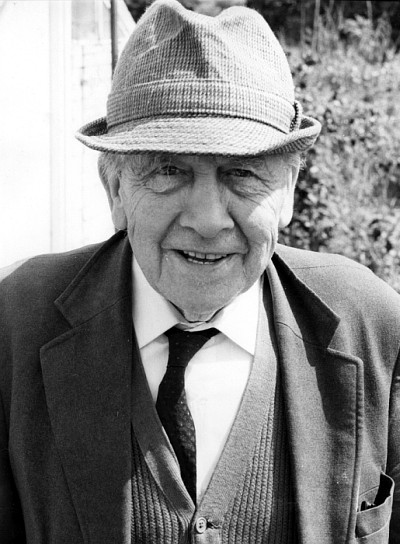 |
|
John Batchelor,
founder of the Tinkers Lane
Nursery |
The early history of Batchelor’s nursery in Tinkers Lane, between
Wigginton and Tring, is largely a story of one man’s enterprise and
determination. John Batchelor was born in 1904 in Heath End,
and received a basic education at Hawridge village school. He
obtained a job at a large house in Berkhamsted, working as a
gardener and chauffeur, and at the early age of 20 fell in love and
married the cook (a wise choice). As a wedding gift from their
kind employer, the couple received half an acre of ground in Tinkers
Lane, on which John resolved to start his own landscaping business
and build a bungalow for his future family.
By 1925 both projects were well under way and, as John had no means
of transport except his push bike, he hired a lorry to carry stone
from the Cotswolds with which to build rockeries for his customers.
He also supplemented his income by keeping chickens, turkeys, pigs,
and a cow. The latter proved a particularly good source of
revenue, as John was able to sell milk for use at nearby Champneys
health spa, and in return collected their waste for use as
pig–swill. The nursery side of his business was established in
1932 when he bought three redundant greenhouses from the famous
Lane’s of Berkhamsted for £5. He added a further acre of
ground to his existing holding, and began to specialise in rose
growing. He became so well–known in the district that he was
asked to judge at many notable horticultural shows. This
activity was interrupted by the Second War when all production from
market gardens was channelled into vegetable growing. Later,
three more acres and a wood were added, which included part of the
historic Grimsditch. The nursery continued to expand with most
stock being grown on site from seeds, cuttings, and grafts.
John Batchelor was still working at the nursery well after his
eightieth birthday, alongside his son, Tom, and three grandsons.
The total area now covers 12 acres. Today, when ‘garden
centres’ often combined with a DIY superstore seem to be the
preferred choice of many, Batchelor’s nursery remains a traditional
market garden where good plants may be purchased at sensible prices.
Seventy years after John first set up his enterprise, any local
gardener can now say simply “I’m just popping up to Batchelor’s”,
and everyone knows just what he or she means.
In the years immediately after the second war, a Swiss named Boudet
acquired seven acres adjacent to Kiln Lane, Cholesbury, where he
erected three greenhouses. He built an adjoining bungalow
where he lived with his wife and her pet hen. His crops grew
well, for Boudet maintained that there was no better manure than
watered–down cowpats, which he collected from nearby Kiln Farm.
Thanks to this method, he was able to grow splendid Rhubarb plants
to provide the main outdoor crop.
Another enterprise was that of Robert Hedges, who owned a
greengrocery business in Miswell Lane, Tring. In the mid–1930s
he bought an adjacent site which included two small greenhouses and
an old wooden shed with beams covered with nails, where rabbit skins
were once hung to dry. He added two larger glasshouses, one
from The Bothy (see Chapter 4) and, with
the addition of a propagating house and brick cold–frame, soon
started to grow a variety of crops to stock the Hedges family shop
(nowadays The Old Stables). One of the original
greenhouses was converted to a boiler house providing heat for the
other houses and steam for sterilising the soil. His nephew
remembers that someone had often to rise at 3 a.m. in bitter winter
weather to check that the boiler was functioning properly.
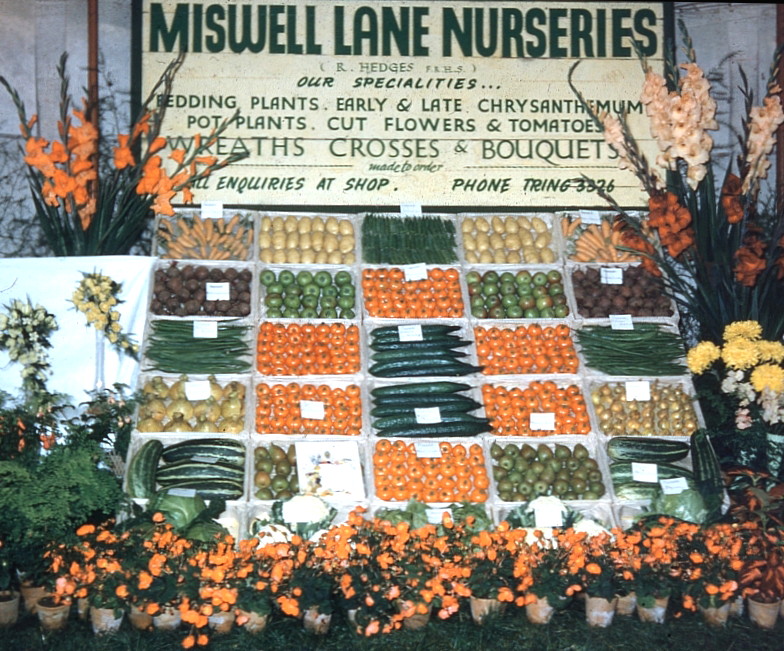
Miswell Lane Nurseries, 1960s
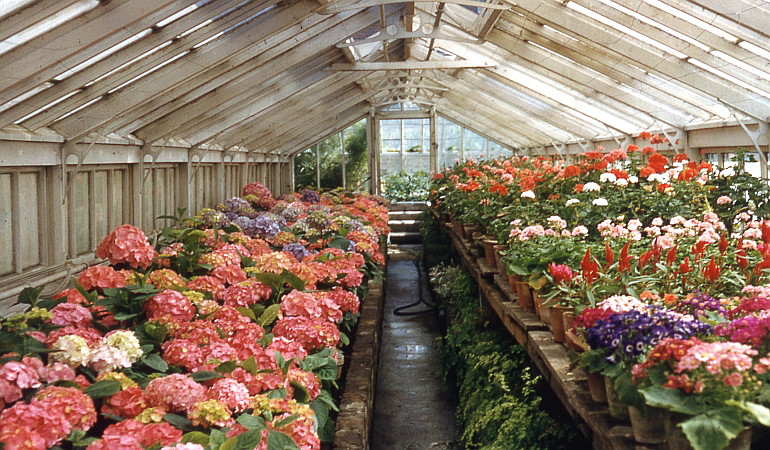
Robert’s nursery was a success, and he employed three full–time
workers, assisted at busy times by members of his own family.
The crops included vegetables, salad plants, cucumbers, and
tomatoes, as well a selection of pot and bedding plants, and cut
flowers. When a large piece of ground (now Cobbett’s Ride)
opposite the existing business became available, the nursery gardens
were expanded. During the second world war chickens and a few
pigs were also kept, their swill being prepared on the boiler in the
old greenhouse. Some older Tring residents still have good
memories of Hedges’ produce being freshly picked in the morning,
sold in the shop during the day, and on their supper tables the same
evening.
Only one traditional nursery remains in the Tring area (Batchelor’s
in Tinkers Lane), and one modern garden centre at Bulbourne has been
established in recent years. However, for those not fond of
DIY in the garden, services of landscape designers are in demand.
Charles Hogarth, whose business is based within the old walled
garden of the Tring Park estate, is a member of the Association of
Professional Landscapers. His work often features waterscapes
and nightscapes, and has won several awards, including the APL
Design and Build Commercial prize for the creation of a beautiful
layout at Bedford Butterfly Park.
――――♦――――
CHAPTER 4
TRING PARK GARDENS – THE ROTHSCHILDS
|
A garden
that one makes oneself becomes
associated with one’s personal history and
that of one’s friends, interwoven with one’s
tastes, preferences, and character.
Alfred Austin (1835–1913) |
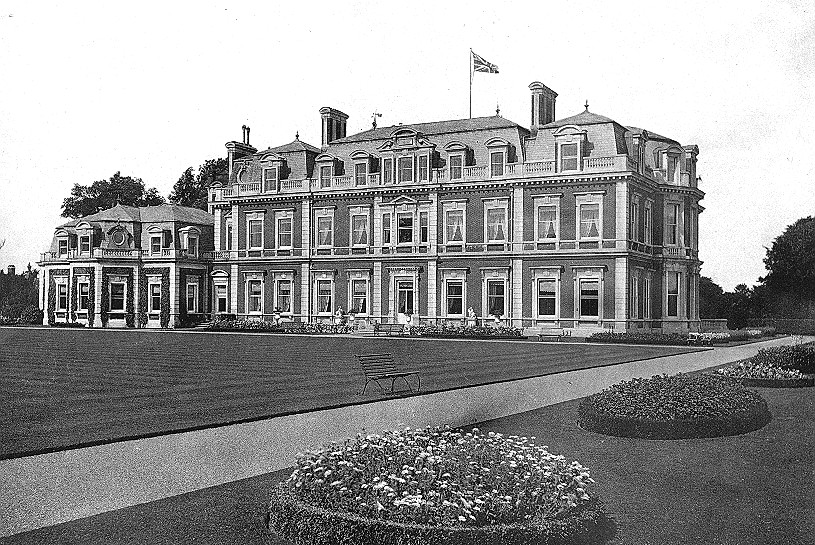
Tring Park Mansion,
South Front, c.1900
Unlike many of his relatives, the first Lord Rothschild was not a
passionate gardener, and practical matters relating to farming and
agriculture held far more appeal for him. However, in the 1880s when
Tring Park Mansion was remodelled, substantial alterations to the
gardens were also undertaken. As the new landscape design matured,
Nathaniel Rothschild did become more interested and in fact grew
knowledgeable about the names and qualities of shrubs. His wife is
known not to have favoured too much formal planting, and at the
south front of the house except for a few flowerbeds (sometimes
displaying the Rothschild racing colours of blue and gold), the
landscaping remained soft. The lawn was extended and a new ha–ha
constructed to allow an uninterrupted view to the wooded escarpment
on the far side of the park.
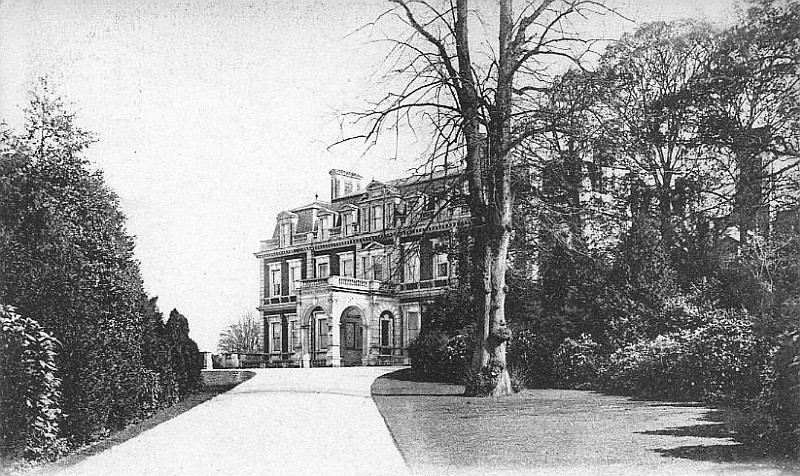
Tring Park Mansion,
North Front c.1900
The area known as ‘the pleasure gardens’ to the west and north of
the house was extensively remodelled and replanted. A description
written at the time records that they featured a summer house and an
Italian garden and fountain. A sunken path, lined with flint, led to
an under–pass which survives. This ran beneath the drive
leading to the stables, and gave access to a winter tennis court; a
topiary garden clipped into the shapes of tables, chairs, and chess
pieces; a Dutch garden; an Elizabethan garden; and a number of other
areas. An account in the gardening press at the time says:
“Each of
these little gardens is complete in itself; once entered, the whole
comes under the eye in an instant, but nothing is seen of the
gardens beyond, for each of these separate designs is encircled by
an irregular bank, planted with rare Conifers and shrubs, faced with
flowering plants, Lilies, and Roses, and in all cases with as many
annual or perennial sweet scented plants as possible”.
The account
reads on to wax lyrical about all the chosen bedding, including
purple Clematis, Begonias, Violas mixed with silver Pelargoniums,
Cannas, Marguerites, white Nicotiana, and Sweet–peas.
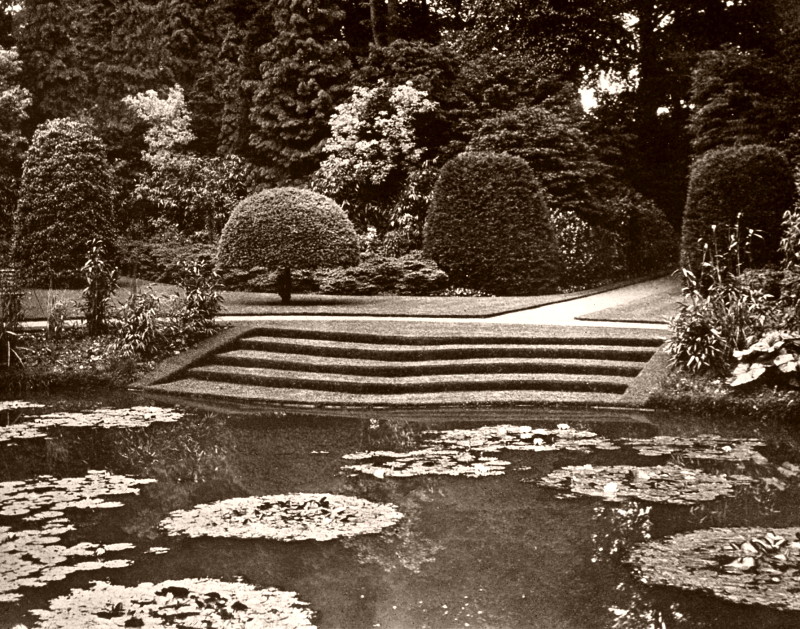
Lily Pond and Turf Steps at
Tring Park
That same year, a correspondent from The Gardeners’ Chronicle
visited Tring Park, and in his article he comments with surprise on
the modest entrance and approach to the estate. But once beyond the
stables area, matters obviously lived up to his expectation of a
home appropriate for the richest man in the British Empire. The
following extracts give a good description of the gardens at that
date:
“A broad new carriage drive leads to where a grand entrance to
the house is evidently meditated, and on the right of this approach
is a bank of evergreens. It was planted only eighteen months since
with large shrubs of Yew, Bay, Box, and Aucuba japonica
............. Passing round the house you will find a lawn, much
enlarged recently, and clipped about by a very unlevel park,
beautifully planted with clumps of Limes, animated by deer and
shorthorns, and enclosed by masses of encircling Beech woods on the
high ground which bounds the view.
........... Among the proofs of outlay, as well as of excellent
taste, are the numerous costly shrubs around the house, including
the bushes of Golden Yews grown from cuttings, as well as the much
rarer seedlings. I dare say thousands have been expended in shrubs
lately ...... Numbers give only a mechanical idea of works of
planting like those which Mr Hill (the head gardener) with his men
and long hose has brought to such a successful issue; but it may
please nurserymen, and make their mouths water, to repeat that 500
Golden Yews, costing a great sum, have been planted here, and 10,000
bulbs of Gladioli set in the shrubberies to enliven them. ..........
I can only say that it (the garden) is filled with costly “things”,
and in standing before the largest Japanese specimen, which is many
times repeated in smaller sizes, one cannot help counting the cost. It is the beautiful Retinospora obtusa nana aurea and is worth seven
guineas. The double Spanish Gorse is used as an edging of this grand
clump of shrubs, and I observed several specimens of weeping Yew on
stems one foot or more high, and then spreading horizontally
..............
The kitchen gardens are on the roadside near the town, and will soon
be entirely shut in by walls, and enlarged from three to six acres. The glasshouses are numerous, and the management unsurpassed. Five
houses are devoted to Orchids, and two entirely to Carnations, one
of them to the favourite Malmaison. The foliage plants, Crotons,
Caladiums, Alocasias, Dracænas and others were superb, and the
varieties of Begonia and Coleus looked charmingly bright. I believe
that a London firm decorates the London house so far as pot plants
are concerned; but the cut flowers are sent from Tring, and two
houses of Adiantum ceneatum are required for the growth of Fern
foliage by the bushel.
There are five vineries where the Muscat of Alexandria Grapes, of
five years’ growth, are as good as can be, and the adjoining Black
Hamburgs too having this year the largest berries yet produced here.
In the Fig-house the first crop was just over, and the second coming in ............. The Orchard-house is simple and comparatively
inexpensive. It consists of 135 yards of wall, enclosed by glass,
having hot-water pipes to keep the temperature above freezing, and
making all the wall fruit – Apricots, Peaches, Pears, and Plums –
perfectly secure.”
The article goes on at great length in the same vein, and also makes
mention of ‘the cottage’, the home of the unmarried gardeners. This
was replaced in 1905 by The Bothy, a fine new building where the
boys were well-cared for by a housekeeper. It survived for almost
one hundred years, until demolished to make way for a supermarket.
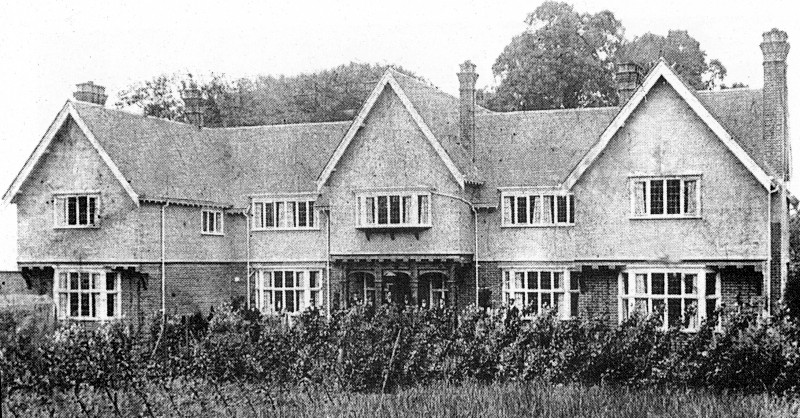
The Bothy c.1905
By the time of Lord Rothschild’s grandson, matters were beginning to
change. By that date, death duties and the effect of a devastating
world war had taken their toll. A description written by Bob Poland,
recently appointed as Greenhouse Foreman at Tring Park, gives some
idea of how things were.
Arriving at his new job one Saturday evening in November 1934, he
was stunned when the head gardener called for him at The Bothy at 9
a.m. the next morning. He was instructed to start cutting fresh
flowers ready to be sent to the Rothschild houses in London and
Cambridge. On enquiring when they were wanted, he was told to leave
them in water overnight, but to be up at 3 a.m. the following day
“as the van calls at 6.20 a.m.” and only two men would be available
to help. Bob Poland’s new empire was larger than anything he had
experienced before, and he describes the glasshouses with 18 miles
of piping and boilers consuming 30 tons of coke each week, all
shovelled by hand. These glasshouses were not as they had been in
their heyday, and Bob recounts they “were in an awful state with
every known greenhouse pest – thrips, mealy bug, red spider, and
millions of ants”. In an attempt to rid the gardens of pests, he
persuaded the head gardener to pay the men so much each for the
tails of rats, mice, moles, and for Queen wasps.
Once the major problems had been dealt with, Bob came to enjoy his
job as his duties were varied. When the family was in residence, his
responsibilities included supplying and arranging all the floral
decorations in the house. Busying himself in the flower room on the
ground floor of the mansion, Bob provided the sumptuous arrangements
that were changed twice a week, and those in the dining room once a
day, or sometimes twice. At the festive season a huge 30 ft.
Christmas tree stood in the centre of the staircase well, and
hundreds of flowering pot plants were used to decorate wherever
space permitted.
In the second world war not much time or effort could be spared for
gardening, and the grounds of Tring Park became neglected and
overgrown. During the conflict the staff from the Rothschild bank in
the City of London moved into the house, and the stables were used
by the Home Guard, the ARP, and the Red Cross. Shortly before the
war, the 3rd Lord Rothschild had offered Tring Park house, grounds,
park, and woodlands as a gift to the British Museum of Natural
History. The committee appointed to consider this did not accept it. The mansion
later became the Arts Educational School; part of the
‘pleasure gardens’ was dedicated as the Memorial Gardens (see
Chapter 12); The Bothy was used to house engineering staff from the
Royal Mint Refinery in Brook Street; and the route of the A41 bypass
sliced through the park. Like many similar estates all over the
country, the golden days were over and nothing was ever the same
again – sic transit gloria.
――――♦――――
CHAPTER 5
HEAD GARDENERS
|
A Gardener’s Work is never at an end;
it begins with the Year, and continues to the next.
John Evelyn (1620-1706) |
For many years, the pretty Regency house with Gothic-style windows,
was the home of successive head gardeners on the Tring Park estate.
It enjoyed an open aspect and was not shielded from the London Road
until much later, when high brick walls were built to enclose the
entire kitchen garden. During the early Victorian period the
various occupants included William Brown, William Ivory, and James
Smith, who also ran a seed merchant’s shop in the High Street.
The privilege of living in the Garden House did not come
easily because, on any large country estate, the head gardener was a
figure of immense importance, whose knowledge of gardening matters,
control of men, and organisational skills were expected to be
all-embracing. But in 1877 this did not prevent the Rothschild
family appointing to the post a youthful 27-year old Gloucestershire
man, Edwin Hill.
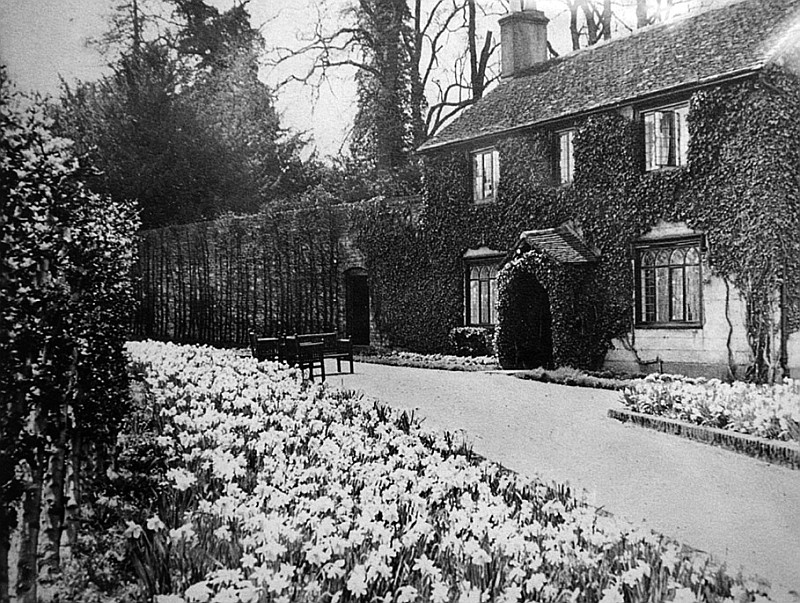
The Garden House c.1905
For the next 27 years Edwin reorganised and maintained the grounds
around the Mansion. As his experience grew, he became
recognised as a well-respected member of his profession, and was
rewarded by being elected to the committee of the Royal
Horticultural Society. He also laid out the gardens of the
newly-built Louisa Cottages in Park Road, and those of the
Isolation Hospital on the road to Little Tring. He acted as
Secretary of the Cottage Garden Society (see Chapter
2), an organisation close to Lady Rothschild’s heart, and was
expected to arrange the athletic sports on show day. Edwin
died at the early age of 54 and his obituary appeared in the
Gardener’s Chronicle magazine.
Edwin was succeeded by his assistant of eight years, Arthur Dye, who
came to Tring Park with the very best credentials. Born
in Norfolk, he started his career in the Royal Gardens at
Sandringham and later moved to Royal Lodge, Windsor.
When he arrived to take up his new position, Arthur and his wife
were tenants in one of the Louisa Cottages but, after Edwin
Hill’s untimely death, they moved to the Garden House within
the walls of the kitchen garden. Living in this splendid house
had, at times, certain disadvantages. On spring nights when
the apple-blossom was in flower, a bell sometimes sounded a warning
that the outside temperature had fallen below freezing point: Arthur
then had to leave his warm bed to ensure that fires were lit in the
orchards. (Propped up in his bedroom was a shotgun, which he
used to despatch any unwelcome Glis Glis who trespassed into
the loft space.)
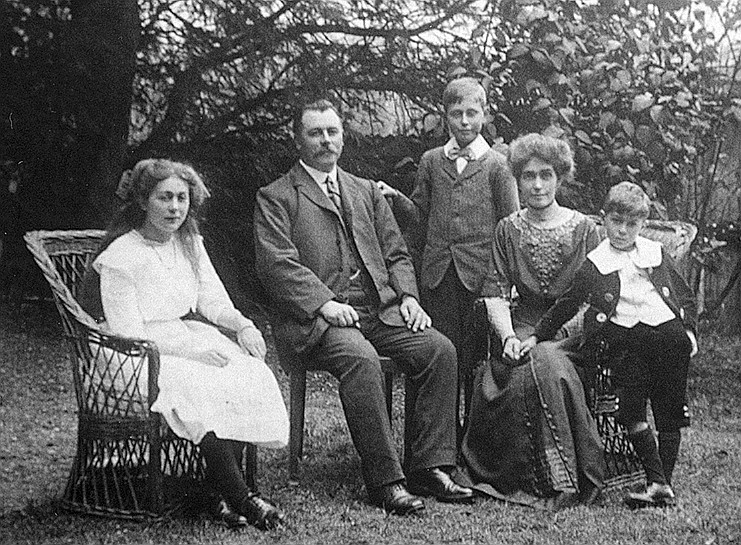
Arthur Dye, head gardener at Tring Park,
with his family
His new responsibilities included the welfare of the unmarried
gardeners living at The Bothy (see Chapter 4). Liaison
with other senior staff members such as the chef and butler were
also part of the job. One very special task each year was a
visit to Buckingham Palace, bearing Lord Rothschild’s gift of
flowers to decorate Queen Mary’s breakfast table. Arthur
remained head gardener for forty years, and on his retirement moved
to a Rothschild property, Woodlands, in Chesham Road,
Wigginton. There he enjoyed 25 years tending his own large
garden where he waged a constant war against Wigginton’s rabbit
population.
In the summer months it was the practice for owners of large houses
to open their gardens to the less privileged local folk of the
district. These events were greeted with mixed feelings by
head gardeners. Their natural pride and pleasure in
compliments, were weighed against possible hazards to their precious
plants. At Tring Park during the annual Agricultural
and Flower Shows, ‘Freedom of the Park Day’ meant all could wander
around the grounds and gardens, but some very necessary preparatory
work had to be done. The park was home to a variety of exotic
creatures belonging to Walter, eccentric zoologist son of Lord
Rothschild. Throughout the year kangeroos, emus, and other
animals roamed freely, but of course had to be kept under control on
the great day. Beforehand, an army of gardeners’ boys were
deployed to clean up the park, in a thoughtful attempt to preserve
the Sunday-best boots and clothes of the visitors.
It was also the case that head gardeners did not always appreciate
the largesse shown by their employers towards the general populace,
especially when children were involved. One hot summer, the
owner of Stocks House at Aldbury, the writer Mrs Humphry
Ward, a typical example of a Victorian lady bountiful, had the idea
of opening her kitchen garden and allowing the village children to
visit her strawberry beds. In spite of the disapproving eye of
her head gardener, Daniel Keen, they took full advantage of the kind
offer. His apprehensions were realised and he was obliged to
send the children packing for trampling his plants. Mary Ward
must have listened to his woeful description of the episode, as the
following year a better idea was suggested. The village
children were invited to a strawberry tea with cream, laid out on
long tables on the lawn of Stocks House.
Daniel had already been at Stocks for fifteen years before
the arrival of the Wards in 1892, and he lived long enough to gather
the branches of wild cherry that decked his mistress’s grave in
1920. In summer he often worked for fifteen hours a day, and
his simple answer to his employer’s protestations was that he could
not bear to see his plants die for lack of watering. He grew
to know exactly what would most please Mary Ward, and at
Christmas-time filled the house with hyacinths, narcissus, and banks
of azalea. He also achieved wonders in the walled kitchen
garden, as large amounts of produce were sent from Tring Station to
the charitable settlement for children that Mary Ward had founded in
London. During the war Mary and her daughter between them
devised a scheme of “war economies” which was implemented
vigorously. Timber was felled, potatoes grown, jam was made,
and garden fruit shared with the villagers of Aldbury. As all
the gardeners were serving in the army, the family helped Daniel by
planting out bedding and seedlings, and even the butler was
recruited to cut the lawns.
Daniel Keen was not alone in his devotion beyond the call of duty,
as gardeners in charge of extensive grounds surrounding large
country houses often seemed to love these gardens as much as their
own modest plots. The same feeling was brought to Drayton
Manor by Thomas Bateman, who tended the gardens until well past
his eightieth birthday. Tom, who had been in the employ of
Miss Alice Rothschild at Eythrope Park, came to Drayton on
the extreme western edge of Tring in the mid-1930s. With his
wife and young daughter, he settled in the lodge house at the
entrance to the drive in Aylesbury Road. He was proud of his
place of work, and with great enthusiasm set about organising the
lovely gardens, which had far-reaching views towards the Chiltern
escarpment.
The second world war changed everything when Tom left to serve in
the army, and Drayton was converted to a hospital for wounded
soldiers. However, the grounds continued to be enjoyed, as
every summer fêtes were held with a variety of activities designed
to help cheer up both the convalescent soldiers and the residents of
Tring. (These carried on for a few years afterwards, and in
the early fifties Godfrey Wynn, the celebrated broadcaster,
performed the opening ceremony.) After the war, the house
stood empty for two years before becoming a school for blind
children. While it was unoccupied Tom kept an eye on the
premises, and on more than one occasion he glimpsed the resident
ghost that all old houses claim. This took the form of a Grey
Lady flitting through the upstairs rooms. When the house
reverted to a private residence in 1957, the Batemans left the lodge
to live nearby. Tom continued to look after the gardens, and
remained until his wife’s ill-health forced him to retire. The
Batemans loved Drayton Manor so much that their
daughters thought it fitting that their ashes be buried in the Manor
gardens.
At the end of the Victorian era, when the Williams family of
Pendley Manor departed in August to shoot grouse in Scotland,
the gardens were opened to the public on several occasions.
The head gardeners (Henry Amos, followed by Frederick Gerrish)
always received great compliments on the appearance of their
gardens, but kept an eagle eye on proceedings. As the tennis
courts, bowling green, and croquet lawn were also open for the use
of all, they were wise to do so. Around the 1920s the position
of head gardener was held by Thomas Westcott, whose son Douglas was
for many years the star fast bowler of Tring Cricket Club.
In the centre of Tring once stood a large house, Frogmore,
which took its name from the street in which it was situated.
It was the home of Thomas Butcher, owner of the town’s private bank,
established in what later became the NatWest building in the High
Street in the 1830s. Thomas at first lived over the premises
enjoying the large garden area behind, but when his son inherited
the estate Thomas took advantage of the natural springs at the
bottom of Frogmore Street to include several water features in
Frogmore’s overall garden layout.
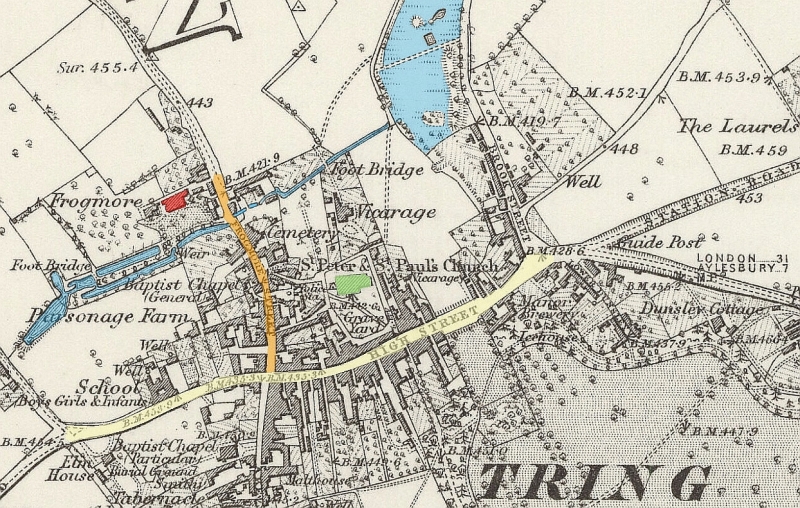
OS map of Tring (1877-79)
Frogmore is shaded red, the Parish
Church green, and the springs blue
At the turn of the century the head gardener was Joseph Reeve, a
local man who had been born in the now-vanished hamlet of Lower
Dunsley (once diagonally opposite the Robin Hood). He
was also responsible for overseeing the maintenance of the large
garden at the rear of Butcher’s Bank in the High Street.
Joseph lived with his family in one of a pair of pretty cottages
opposite The Black Horse. He was expected to supply
choice examples of fruit from the orchard, and vegetables from the
kitchen garden to exhibit in the local horticultural show (see
Chapter 2). Along with other head gardeners
in the area, he enjoyed considerable success. However, their
names never appeared on the winner’s certificate or challenge cup,
for it was always their employers who received the credit. In
any case, all Joseph Reeve’s efforts were swept away in 1956 when
Frogmore, the grounds, the water gardens, the gardener’s cottage,
and 18 acres of land were sold for redevelopment.
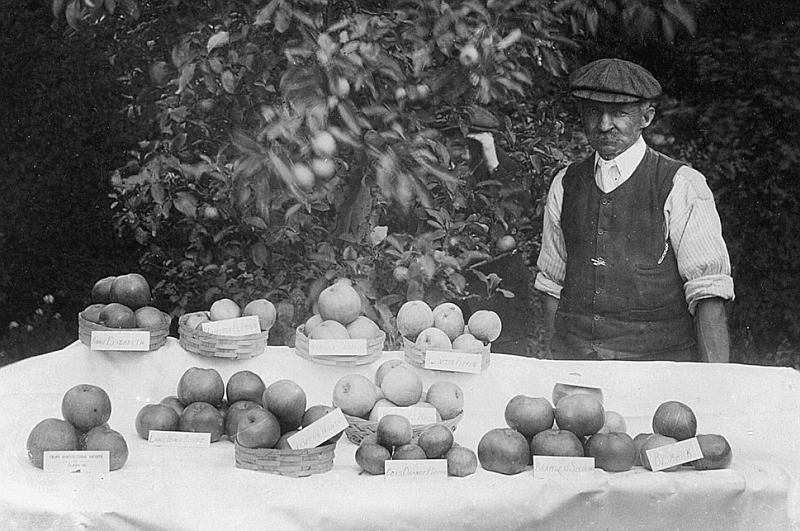
Joseph Reeve, head gardener at Frogmore,
with prize-winning apples
In an account of January 1902 we learn that less-exalted gardeners
were eager to learn from these acknowledged experts. One cold
evening a large and attentive audience gathered in the Boys’ School
at Tring to hear one of a series of lectures arranged by the local
Technical Instruction Committee. The speaker, Hedley Warren,
head gardener to Lady de Rothschild of Aston Clinton House, took
‘Cottage Gardening’ as his theme. Hedley did not talk about
subjects we now associate with olde-worlde gardens such as pretty
hollyhocks and delphiniums, but concentrated on the all-important
practicalities of soil, manures, and garden pests. He was
helped in his task by Frank Grace who operated a magic lantern which
illuminated diagrams on to a suspended white sheet.
Before the age of Women’s Lib, the gentlemen of Tring Park Cricket
Club proved what an enlightened group they were. For the first
time in the 120-year history of the Club, a female groundswoman was
appointed, with complete responsibility for the total four-acre
area. Mrs Elsie Gooch had been trained at Suttons (famous seed
merchants), and later was appointed gardener to F. J. Rodwell who
owned Tring Hill Café (renamed The Crow’s Nest).
Her new duties included preparation of the pitches; care and
maintenance of the table; re-turfing the ends after each game; and
planting and tending the flower beds in front of the pavilion.
At the end of the first season, members expressed themselves well
satisfied with their new groundswoman, and from then on Elsie,
sitting on her motor-mower, became a familiar sight to passers-by in
Station Road.
――――♦――――
CHAPTER 6
TRING RAILWAY STATION GARDEN
|
And in my flower-beds, I think,
Smile the carnation and the pink;
And down the borders, well I know,
The poppy and the pansy blow.
Rupert Brooke (1887-1915) |
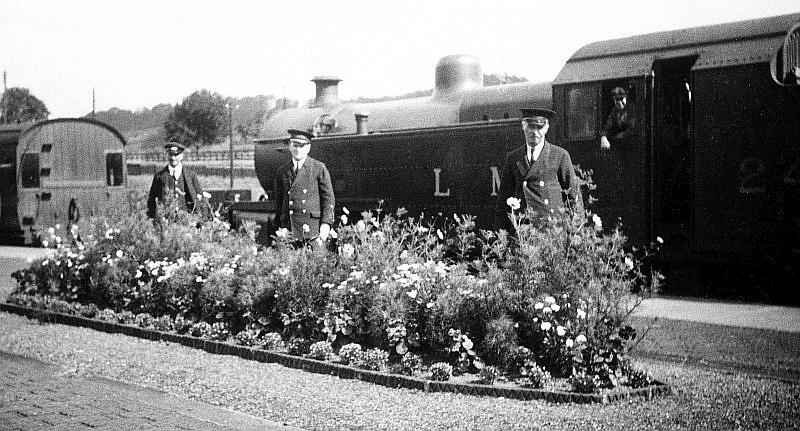
Tring Station flowerbeds
Gardens have been a feature of British railway stations for more
than a century. In past times these displayed anything from a
few milk churns full of geraniums to an intricate French knot
garden. Railway companies encouraged their staff to create and
maintain station gardens by offering prizes for the best examples.
All could participate – the
station-master, porters, ticket clerks, and signalmen. The
judges often used track-inspection carriages (nicknamed ‘glass
coaches’) to travel the length of the line, viewing exhibits.
In the summer months, rail passengers made special train journeys
just to admire and appreciate the efforts of the station staff.
In 1910, the heyday of the golden age of travel by steam, the London
& Northwestern Railway Company announced that a sum of money would
be allocated for the purpose of making stations more attractive.
Many station-masters in the district welcomed the offer and adopted
the scheme with enthusiasm. Not only was this an appeal to
their Edwardian pride, but cash prizes were to be provided by the
recently formed L&N.W.R. Southern Division Horticultural Society, as
well as an award for the best platform in the district.
At Tring, station-master Bradley set to work with a will. This
was no mean task, as the three platforms at his station totalled
about a mile in length. He drew up a design, and an appeal
went forth to the principal residents of the area for trees, shrubs,
plants and everything else necessary to complete his ideas. Mr
Bradley was not short of willing helpers, as eleven of his staff
were keen gardeners and they planned to enter exhibits of their own
at the the railway company’s summer show at Pinner. An account
of the time relates “they all placed their services ungrudgingly
at the disposal of the station-master, and worked with hearty good
will to carry out his plans”.
Some trees and shrubs were planted in the ground, while others stood
in large tubs. Hanging baskets were suspended from the
platform canopies; stands of flowering plants were placed in
suitable spots; and fern rockeries were erected in several hitherto
bare corners. Unsightly banks were filled with trees and
plants, and on the centre platform a large grotto, made of Leighton
sandstone, was covered with plants in bloom.
The area in front of the station-master’s own house was included in
the judging, and planted out with some nicely-arranged flower beds.
Berkhamsted, Cheddington, and Boxmoor were other local stations
entered for the competition, but it is not recorded who won in 1910.
Whatever the outcome, the station gardens at Tring were planted,
maintained, and enjoyed for many years afterwards.
――――♦――――
CHAPTER 7
HERBS AND WILD PLANTS
|
Lavender hanged up in houses, it doth
very well attemper the aire, coole and make
fresh the place to the delight and comfort
of such as are therein.
John Gerard, 1597 |
It may be surprising to read that the sometimes not-so-fragrant air
of Victorian Tring was once scented with aromatic herbs. What
was considered ‘the most fertile field in Tring’, an area bordering
the ancient stream in Brook Street, was given over to the growing of
herbs for use in scent and other products. Around 1830 an
enterprising gentleman named Henry Narraway opened a small factory,
or lavender mill, in a dilapidated property adjoining a mud-walled
cottage which was the original place of worship for New Mill
Baptists. As well as the field in Brook Street, he grew
lavender on Tring Hill at a site close to the right-hand turn to
Drayton Beauchamp. This area was especially suitable for this plant,
for lavender can thrive on a thin chalk soil providing it enjoys
sunlight for several hours each day.
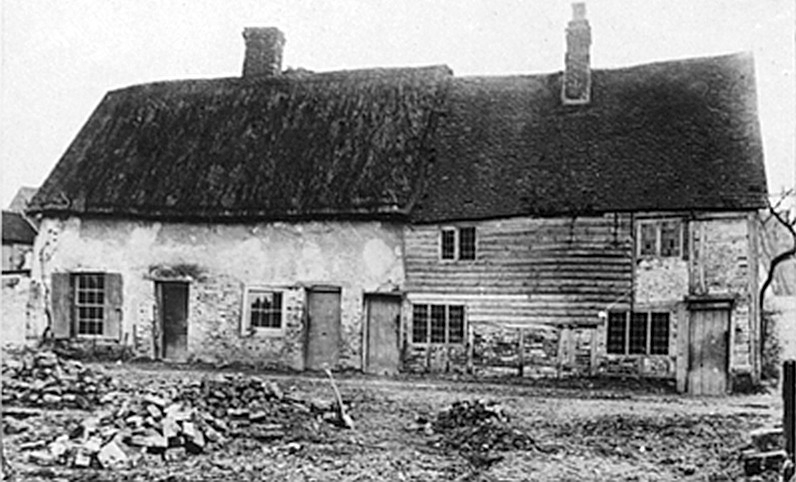
Lavender mill off Brook Street, New Mill
Other herbs grow well in these conditions, and some years later at
Pendley Beeches a natural bed of Belladonna was exploited for
commercial reasons. This poisonous alkaloid plant produces
atropine, a mildly anti-spasmodic drug extensively used in
pre-medication. The bed at Pendley was harvested and
replanted, and was reported to produce a leaf and root of better
quality than the imported Balkan variety. During World War I,
the benefactor from this activity was the Red Cross Society in
Tring. The same Belladonna bed at Pendley was re-discovered in
the second war and again harvested for use by military doctors.
Another, unnamed, Tring entrepreneur hit upon the discovery that
Hollands gin was good for the treatment of lumbago and rheumatism,
ailments then difficult to relieve. His researches led to the
fact that it was the addition of the juniper berry to gin which
produced the effect, eliminating acids from the blood through the
kidneys. He assiduously collected large quantities of these
berries from the Halton hills with the idea of producing a patent
remedy, but found that the supply was limited, even if he searched
all the slopes of the Chilterns. To acquire sufficient
quantities of berries meant dense cultivation of the juniper plant,
and also a considerable outlay of capital. Apparently the
would-be inventor then found that his idea was not entirely
original, as in fact sixpenny-bottles of Oil of Juniper were easily
obtainable from any Boots’ chemist shop.
Gathering wild plants was an important and useful activity during
the first world war. In 1917 the headmaster of Tring School
was asked to arrange the collection by pupils of horse chestnuts.
(It is likely to suppose that the boys kept the choicest conkers for
themselves). The active ingredient of the horse chestnut is
aescin, long known to relieve a variety of unpleasant conditions,
including vein problems, inflammation caused by arthritis and
swellings, and fevers.
The following autumn the local Food Control Committee extended the
request to include blackberries, and again the headmaster was
appointed as agent and organiser. Parties of children were
despatched to the hedgerows of Tring, their efforts totalling 190
lbs. which all went for jam-making. J.G. Williams of
Pendley Manor encouraged the children’s efforts by offering a
silver trophy to be awarded to the local school contributing the
largest amount. W. J. Rodwell of Tring Brewery acquired 12,000
redundant wooden butter boxes for transporting the blackberries, and
engaged women and girls to carry out the necessary sorting and
repair work.
Herb gathering was again very necessary in World War II when the
herbalists of Britain could no longer obtain their supplies from the
Continent. The wife of a Tring doctor, Mrs O’Keefe, and Lady
Craufurd of Aldbury organised the collection of wild plants for
medicinal purposes. Children were eager to help, and glad to
supplement their meagre pocket-money by the two-pence or
three-farthings a pound that the dealers paid. Ladies from
local Women’s Institutes also helped with the collection, and the
results of their efforts were taken in half-hundredweight sacks to a
mill, or furnace, at Dunstable. Below are a few examples of
the plants that the Government requested:
Yarrow (tonic)
Shepherd’s Purse (anti-scorbutic, stimulant, diuretic)
Camomile (carminative, sedative)
Burdock (blood purifier)
Pilewort (self-explanatory)
Digitalis (heart medicine)
Ragwort (cough medicine)
Elder Flower (diuretic)
Coltsfoot (cough medicine)
Belladonna (narcotic, diuretic, sedative)
Poppy petals (cough medicine) |
This last plant was financially the most worthwhile as the petals
fetched one shilling a pound. But as it took 200 petals to make up
one ounce, the money was not earned easily.
Stinging nettles were also on the list, but it seems that Wilstone
W.I. members were the only ones to agree to this rather unpleasant
work. This was a pity as the plant could be put to three different
uses - as a diuretic and astringent; in animal feeds; and,
importantly, as a green dye for use by the Army in camouflage
sacking. The watery ditches around the Wilstone area were a good
source of Meadowsweet, which was used as a remedy for children’s
diarrhoea. The plant that the ladies most enjoyed gathering was
Sweet Marjoram, used as a tonic or a stimulant, and it was said that
nothing was more pleasant than searching out this fragrant herb on a
hot summer’s day.
Some families gathered wild plants for their own use, and these
included the dandelion. This plant had long been known as a general
stimulant to the system, and was useful as both the leaves and roots
can be used. It was taken as a general tonic in either an infusion
or an extraction, and also fresh leaves could be added to salads.
Autumn brought rich pickings and whole families went on expeditions
to the woods and hedgerows to gather blackberries, rose hips, crab
apples, and mushrooms. Hazelnuts were another treat, and to take a
basket and ‘to go nutting’ was a seasonal ritual.
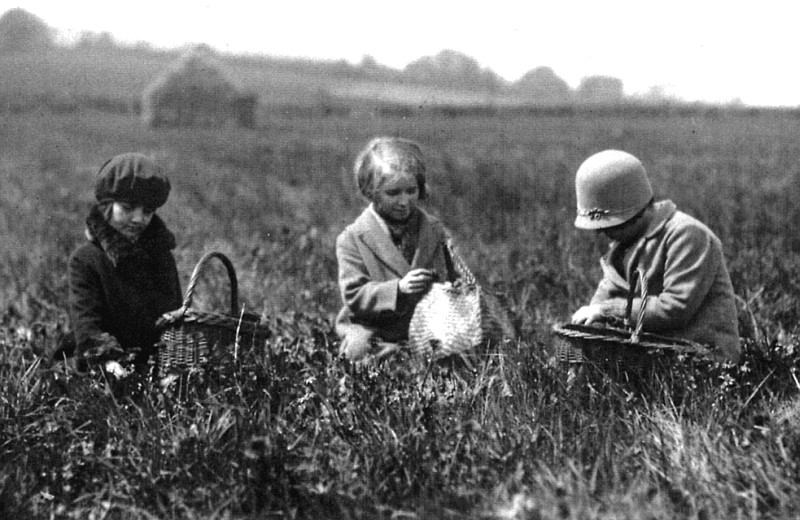
Gathering dandelions off Icknield Way
During and after the second war, long before the dangers were
realised, smoking was both a comforting and fashionable habit. In
the late 1940s some hopeful town residents, (although admitting
Tring was not exactly the Deep South) attempted to cultivate tobacco
plants in their back gardens. Much attention was lavished on
the crop, and buds and side shoots were nipped off to encourage leaf
growth, a task that was not especially pleasant as the leaves were
gummy, and stained the fingers brown. Nevertheless they
persevered, and one gardener from Longfield Road reported that the
leaves on his plants had reached a creditable 20 inches in length.
In a Beaconsfield Road garden another enthusiastic grower really
‘went to town’ and gave over a good section of his entire plot to
the cultivation of 50 tobacco plants. The leaves were duly
picked and hung up to dry and cure, and when ready, this local
tobacco supposedly boasted a ‘Havana flavour’ and was particularly
good for use in a pipe.
When viewing the shelves of present-day health food shops, it seems
that since Victorian times the wheel has turned full circle.
In those days, self-help using herbal remedies was often the only
resort for treating ailments. There is now a marked trend
towards the same thinking, and many prefer to use natural plant
extracts rather than prescribed drugs. In the mid-nineteenth
century in Akeman Street in Tring, William Sexton traded as a
herbalist, selling his products in a small shop. Many of his
remedies, albeit in very different packaging, may have been little
different from those to be found in Harmony today.
――――♦――――
CHAPTER 8
ORCHARDS
|
Beneath these fruit-tree boughs that shed
Their snow-white blossoms on my head,
With brightest sunshine round me spread
Of spring’s unclouded weather,
In this sequestered nook how sweet
To sit upon my orchard seat!
William Wordsworth (1770-1850) |
Tring has never been an area particularly noted for commercial fruit
growing, but reference to local old maps shows that the gardens of
every farm, sizeable house, and even some cottages supported an area
of orchard. In neighbouring villages fruit was cultivated on a
larger scale. At Aston Clinton and Pitstone apples and stone
fruits grew well. The speciality of the area was a natural
seedling plum known as the Aylesbury Prune, a variety
especially suited to soils of mixed clay and chalk. (In many
of these orchards another local delicacy, the Aylesbury Duck,
could be seen foraging under the trees.) Fruit from the
orchards at Pitstone was taken to Cheddington Railway Station, and
in the season it was by no means exceptional for ten to fifteen tons
to be despatched on any one day. A fruit farm at Buckland
Common also provided some jobs at picking time, and the village
supported a small cider factory which employed 13 workers.
However the little sour apples necessary for this product were not
grown on site, but arrived by rail at Tring Station, there to be
loaded on to a steam wagon and taken up the hill.
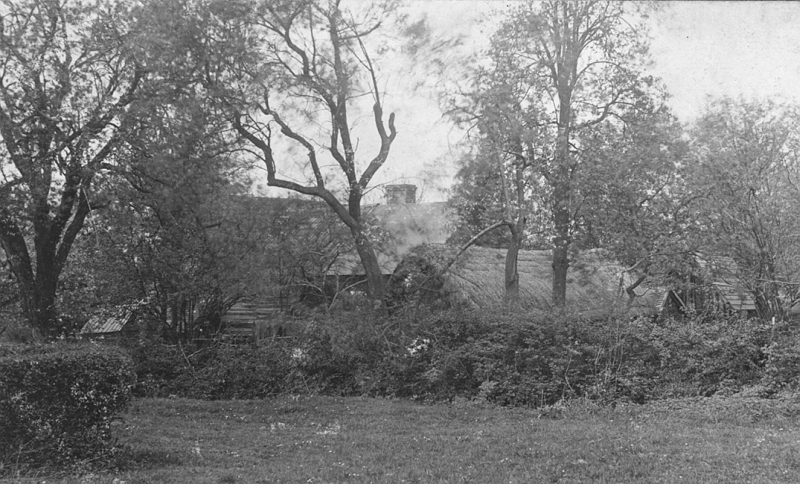
The cider factory at Buckland Common hidden
among the trees
Pallett & Co.’s billhead
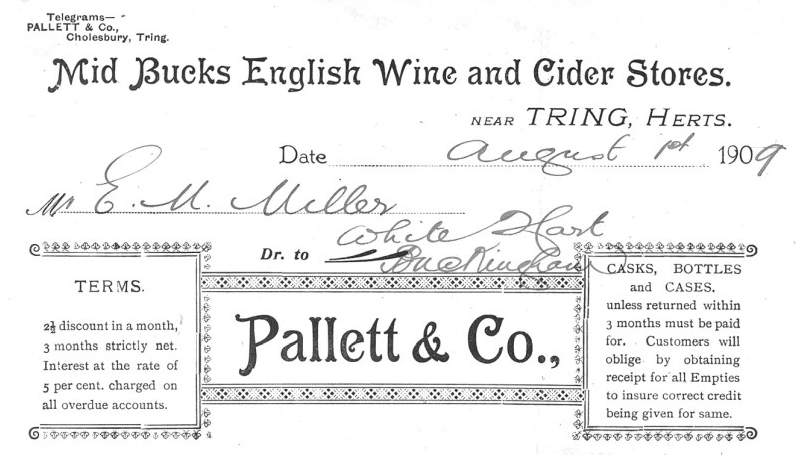
Every large country estate had its own fruit orchard, as well as
kitchen gardens and glasshouses which contained fresh produce for
the owners, their guests, and servants. The orchard of the
Tring Park estate was situated in an area behind Silk Mill
House, on a piece of ground once part of the mill pond which
supplied the huge waterwheel that drove the machinery in the mill.
When water power was later supplemented by a steam engine, the lake
was partially filled in and fruit trees planted. Despite
guarded by a high brick wall, the orchard proved an irresistible
temptation to local lads who were always alert for ‘scrumping’
possibilities. (Some orchard owners sited their beehives among
the apple trees, not just for the purpose of pollinating, but to act
as a deterrent). By the middle of the twentieth century the
fruit trees at the Silk Mill were past their useful life.
Another area known as Dunsley Orchard was sited off the
London Road near the cricket ground. This was probably one of
the oldest fruit-growing areas in the town, as it can be seen
defined as an orchard on an estate map of 1719. In 1938, the
1.3 acre site was offered for sale during the dispersal of the
Tring Park properties. Nearby at The Bothy, the
home of the unmarried gardeners on the estate, a small orchard of
pyramid apple trees was planted in front of the house, and these
were never allowed to get beyond ten feet high.
W. J. Rodwell, who in Tring founded the soft-drinks company that
still bears his name, died in 1958, aged 90. He was a
versatile man who in his youth had undertaken every task on his
father’s farm. Later he studied land surveying, and learned
the process of straw plaiting (his father was a wholesaler of
straw). He was also widely known for his skill as a
horticulturist and fruit grower, and owned nearly 40 acres of
orchard land in Aston Clinton, where he cultivated apples and stone
fruits, including the Aylesbury Prune. Towards the end
of World War I when food supplies were scarce, William Rodwell was
able to help in an active way. In 1917 he supplied over 200
tons of fruit to the Government for drying and preserving, for which
the Ministry of Food requisitioned thousands of hampers.
Problems arose when these were reclaimed by their owners, and
William’s business acumen then came to the fore. He promptly
acquired 50,000 rectangular baskets which had been the standard
container for carrying howitzer shells. Stripped of their
internal fittings, these proved an ideal way to transport the fruit.
In a central depot at the Old Maltings in New Mill as many as 3,400
baskets were packed and despatched in one day. The centre
provided welcome employment for over one hundred mostly home
workers, women, and young people.
The year 1917 must have been excellent for its yield of apples.
It is recorded that in September a man from Tring carried a sack
full of fruit to the outlying villages hoping to sell the contents.
Alas, he could not find a single buyer and, rather than carry his
heavy load back, he dumped it in the road and said to the villagers
“help yourselves” which, of course, they did.
The story of the last working orchard in Tring is interesting.
After the horrors and hardships of World War I ‘Homes Fit for
Heroes’ was a common phrase heard for many years afterwards.
First uttered by David Lloyd George when campaigning during the
‘Khaki Election’ of 1918, like many Government promises it did not
entirely live up to expectations. An Act of 1919 gave local
authorities the task of helping to secure improvements in
working-class housing, as well as land on which to run
small-holdings. The owners of the Tring Park estate
offered Dunsley Farm to Herts. County Council for this latter
use, a gift which was accepted gratefully. The Council however
requested that the farm land fronting Station Road might be reserved
for better-class housing, and this eventually proved to be the case.
A Tring-born man, Walter Wilkins, became the tenant of the
farmhouse, and another ex-serviceman also benefitted from the new
scheme. Andrew Jeacock, from Warwickshire, was fortunate to be
granted an area of four acres off Cow Lane. A timber-framed
and elm-weatherboard bungalow and barn were constructed on the site,
and apple and plum trees were planted. Andrew combined this
work with his job as gardener to Miss Williams at Hawkwell in
Station Road, and as Green Ranger at Tring Bowls Club. Until
1959 he lived at Dunsley Bungalow, when his life ended
tragically at age 75. Although suffering from advanced
Parkinson’s Disease, Andrew continued to potter on his
small-holding. One bright August morning he busied himself in
the orchard, burning some dry grass. There, he stumbled over
an anthill and fell into the fire.
During the following years the bungalow had several different
occupants including one tenant who tapped the existing well to lay
on piped water to the orchard. Others used the property as the
base for a kennel business.
In 2003 came the threat of redevelopment when the Dunsley Action
Group was formed to fight proposed building plans. Martin
Hicks is an ecologist who for 18 years has lived at Dunsley
Bungalow, and holds the farm tenancy for two acres. He has
maintained much of the original orchard, which yields up to 3,500
lbs of apples and plums. Martin was instrumental in starting
Tring’s Own brand of apple juice, supplied in green bottles
which contain the juice from the organically-grown apples at
Dunsley, as well as from an orchard in Cheddington.
To members of Tring Environmental Forum the threat of demolition of
the bungalow and the construction of thirteen dwellings on the site
in Cow Lane was a call to action. Their efforts were not
helped by Herts County Council’s decision to commission an
independent ecological report contesting the Wildlife Status of the
area. In 2004 English Heritage Inspectors visited the site in
Cow Lane. In the report, one of the inspectors wrote “It is
a rare, well documented, almost unaltered example of a home fit for
heroes, and still within the managed holding.” They
decided that the whole site, including the 1920s bungalow, piggery,
and cart shed, had sufficient historical interest to warrant Grade
II listing.Misteltoe
|
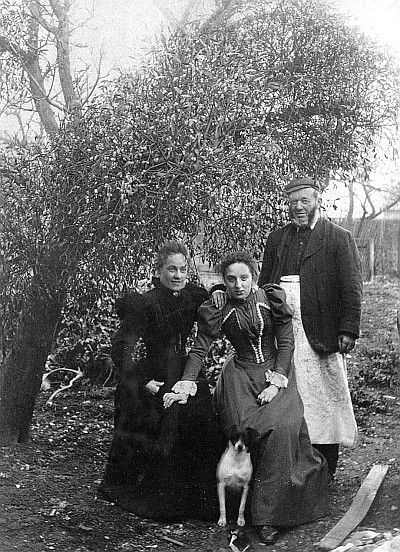 |
|
Mistletoe in the Cato family garden,
1898 |
Until the second world war, an orchard of mixed fruit trees extended
for a considerable distance close to the Icknield Way, in an area
known as Dundale. This was part of the pleasure gardens of the
Tring Park estate, and natural springs were dammed to form a
sizeable lake which was stocked with brown trout and waterfowl.
In the centre of thick woodland, a large lodge house was erected for
the use of Lord Rothschild’s fishing parties. In 1950, to save
it from development, the woodland part of Dundale was bought for
£4,000 by Joseph Eggleton. For many years he maintained it as
his own private wildlife park. Later, the area became
overgrown, the lake clogged, and the house dilapidated. Modern
housing now covers part of the site, but the remaining lake and
woodland have been preserved within a Conservation area.
Apple trees are often the preferred host of the Mistletoe plant, and
this used to provide a welcome seasonal supplement to owners of
orchards. An evergreen plant which mainly relies on
propagation by birds, Mistletoe may have taken its name from the
Missel Thrush. Its appearance is random, and it is a plant
that is extremely difficult to cultivate by deliberate methods.
Although semi-parasitic and gaining nutrients from its host tree, it
causes little damage and its appearance is generally welcomed by
fruit growers. A remarkable mass of Mistletoe in a garden in
Tring was featured in 1898 in The Strand magazine, with a
photograph of the proud Cato family, including their dog.
――――♦――――
CHAPTER 9
ALLOTMENT GARDENS
|
The work of a garden bears visible fruits
–
in a world where most of our labours seem
suspiciously meaningless.
Pam Brown, b.1928 |
Tring Charities, established in the seventeenth century, provided
benefits to the 'deserving poor' of Tring and its Rural Parishes.
This was achieved in various ways, including land for allotments on
which people could grow vegetables in their spare time (although
quite what spare time was available in those days of long working
hours and prohibited work on Sundays is hard to imagine). The
records show that poor folk put their efforts into cultivation of
root vegetables, usually turnips, as these were more filling and had
the added advantage that they could be stored during the winter
months.
The General Inclosure Acts of 1804 and 1881 altered the original
holdings in Tring and district, and by the end of the Victorian
period Tring Charities allotment gardens included land at Mortimer
Hill, and Harry’s Ash Allotments. These were in addition to
areas at New Mill, at Bunstrux, and near Tring Station. A site
in Tring Park off Hastoe Lane was cultivated as allotment gardens by
tenants of Louisa Cottages almshouses. All the villages
in the Tring area had plots for rent, owned either by the respective
parish, charity trustees, or benevolent private landowners.
Before World War I, an account in the local paper states that
allotment holders sometimes flouted the rules. Complaints were
voiced that areas intended only for the cultivation of vegetables
were littered with sheds, pigsties and nondescript buildings, and
that some plots were not even well tended. Afterwards the
situation changed markedly, when men returning from military service
needed to feed their large families. An Act of 1922 defined
Allotment Gardens as small plots (not exceeding 40 poles in length),
owned sometimes by private individuals but usually by local
authorities. These had to be wholly or mainly cultivated by
the tenant for production of vegetables and/or fruit crops.
Even before the 1922 Act was passed, it was apparent that the number
of allotments in Tring was insufficient. As was often the way
with local difficulties, an appeal was made by the Council to Lord
Rothschild asking for the release of some land at the western end of
the town. After negotiation, four acres in Duckmore Lane were
relinquished by a local farmer. It was no surprise that the
fifty-eight plots were taken up immediately for, although the rent
was 5s.0d. a year, the Rothschild estate issued all allotment
holders with a voucher for 7s.6d., exchangeable for beef at
Christmas. The only stipulation set to growers by Lord
Rothschild was that a root of rhubarb should be planted on each
allotment, some of which are still there to this day. (Why his
lordship was fixated on this particular plant is not known, but he
may have been aware that rhubarb was well-known for one particular
medical property.)
Three years later it was decided to form an Allotment Protection
Society, and Frank Brown, a senior partner in the firm W. Brown &
Co. (later Brown & Merry) accepted the Presidency. Rules were
tightened, and holders were served notice to quit if they did not
maintain their plots in good condition. In that year it was
decided to change the name from Tring Allotment & Gardeners’
Protection Association to Tring Horticultural & Allotment
Holders’ Society (it was said the old name was unwieldy,
although the new name did not exactly trip off the tongue!) In
those days when money was tight, potatoes were an important item for
any family. The Society obtained seed potatoes at an
advantageous price and sold these to members at Butcher’s Farm in
Frogmore Street. As well as King Edward and varieties still
familiar, these included long-forgotten names such as Great Scot,
Sharpes Express, Eclipse, Majestic, Catriona, and Dargill Early.
The young folk of the town were also encouraged to join in, and
William Rodwell offered a piece of land for use by the Tring troop
of Boy Scouts. It is amazing to read now that eighty scouts
eagerly took up plots in order to compete for their proficiency
badges in gardening, with the remainder of the ground being used as
a general troop plot. This activity was viewed as sufficiently
important for Arthur Dye, head gardener to Lord Rothschild, to
inspect the site and award additional prizes.
Seventy years on, the situation is now very different and, with a
huge choice of vegetables from all round the world available in
supermarkets, far fewer people are interested in cultivating an
allotment. Many of Tring’s old allotments are covered with
houses, but some plots do remain. Tring Charities still own
and manage 23 allotments at Mortimer Hill, and also at Potash Lane,
Long Marston, which is partly owned with the Church. The
Hastoe Lane plots continue to be cultivated, and Tring Town Council
own and manage a small site at Bulbourne, and a larger one at
Duckmore Lane (part of which has been planted with the Millennium
Wood, an initiative launched to benefit the town and to support the
Iain Rennie Hospice at Home. Over 1,000 saplings were
planted, and are growing well).
An Allotments Committee now oversee improvements to the area, and a
group of enthusiasts run the Allotments Association, offering
suggestions, obtaining seeds at discounted prices, and exchanging
ideas and help.
――――♦――――
CHAPTER 10
PLANTS FROM ABROAD
|
Different flowers look good
to different people
Chinese proverb |
Some gardeners have found that a chance encounter with one
particular species of plant captures their imagination, and they
then often become ‘hooked’ for life. This has proven to be the
case for several Tring gardeners who specialised in the cultivation
of exotic plants from far-away places.
When Christopher Parslow of Hastoe was incapacitated following
injury sustained during his army service in the Great War, he was
unable to work or undertake any heavy gardening. An iron brace
supported his injured leg, and Chris spent many hours sitting down,
often in his greenhouse, enjoying his large collection of cacti.
He must have been pleased when his young nephew, Leslie, showed
signs of inheriting his interest. Having built up a cacti
collection of his own, Les could not bear to be parted from some
specimens that even accompanied him when he served with the RAF.
Naturally, the cacti were not left behind when he lived in London,
and later in a flat in Tring. By the time Les and his family
settled in a house in Meadow Road, the collection contained hundreds
of different varieties. He became an enthusiastic member of
the local branch of the National Cactus Society and as his knowledge
grew he exhibited and won prizes at County level, as well as at
local shows. He was recognised as an authority on the subject,
and in demand for talks and slide shows.
|
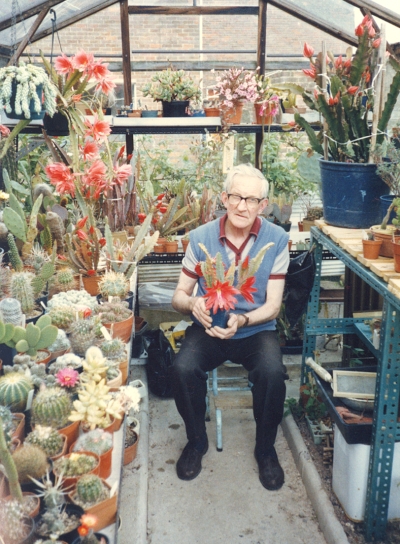 |
|
Leslie Parslow with his cacti |
When Rodney Sims married in the early 1960s, he joined Tring
Horticultural Society to obtain some tips to apply in his new garden
at Nathaniel Walk. At a meeting where Les Parslow was giving a
demonstration on lithops (small wonders of Nature which are
often called ‘Living Stones’), Rodney caught the cactus bug.
He and Les became friends and travelled together to meetings and
shows. Later he held many offices on the committees of both
the Tring Horticultural Society and the Berkhamsted branch of what
is now named the British Cactus & Succulent Society. His
collection numbers hundreds of examples of every imaginable type,
and fills a large greenhouse, several cold frames, and outside racks
for the varieties which withstand frost. Rodney’s finest
achievement was in 2004 when he won first prize at the National show
with his 30-year old Aloe Pearsonii a native of South Africa.
This beautiful plant has cascading red-green leaves and an orange
flower in summer.
Those knowing nothing of cacti often quote “cacti thrive on
neglect” and “they only flower every seven years”.
Both statements are quite untrue. The best results are
obtained from a good open compost mixture, watering in the summer
months, and never allowing the plant to stand in stagnant water.
If they are well tended in this way, most should flower every year.
(However much attention is lavished, none should expect gratitude
from their cactus plants, and should keep a pair of tweezers handy
to extract spines from their fingers.) Cacti are an amazingly
versatile genus, some growing in the hottest deserts whilst others
survive under snow for much of their lives. As with
succulents, which vary in size from the giant Baobab Tree to tiny
plants only millimetres in height, cacti can be slender, fat,
droopy, or bushy. It is a not a hobby for the impatient, as
some species take thirty years or more to mature.
When Les Parslow died, his huge collection was dispersed, some
specimens going to members of the Horticultural Society, and others
to Little Heath Nursery at Potten End. The annual presentation
of the Parslow Cup at the local branch of the British Cactus &
Succulent Society ensures that his name is remembered in the cacti
world. At the end of the nineteenth century those who
undertook the serious study of natural history were expected to have
good knowledge of botany. Walter Rothschild, his brother
Charles, and Karl Jordan (his curator at Tring Museum), all became
deeply interested in this branch of science. Collecting
expeditions to different parts of the world enabled them to bring
back exotic species which they tried, with varying success, to
propagate in England. Karl Jordan’s large garden at his home
in Aylesbury Road, Tring, was filled with specimens gathered on his
travels to Europe and North Africa.
Whenever Walter Rothschild was abroad he sent back copious lists of
plants he had seen. As time went on, his main interest centred
on the tricky science of orchid-growing. He was definitely not
a ‘hands-on’ gardener, but used the facilities of the Tring Park
estate (see Chapter 4) to support his hobby.
The huge run of glasshouses and an army of gardeners ensured that
his planting experiments could be put into practice without
difficulty. He kept meticulous notes of his collection, and
became so knowledgeable that the Royal Horticultural Society awarded
him the Victorian Medal of Honour. Altogether fourteen species
and sub-species of plants were named after him, including five
orchids. Among these were the Anthurium Rothschildianum,
and the glorious Vanda Rothchildiana. This is now rare
in the wild, and in 1993 featured on an English postage stamp.
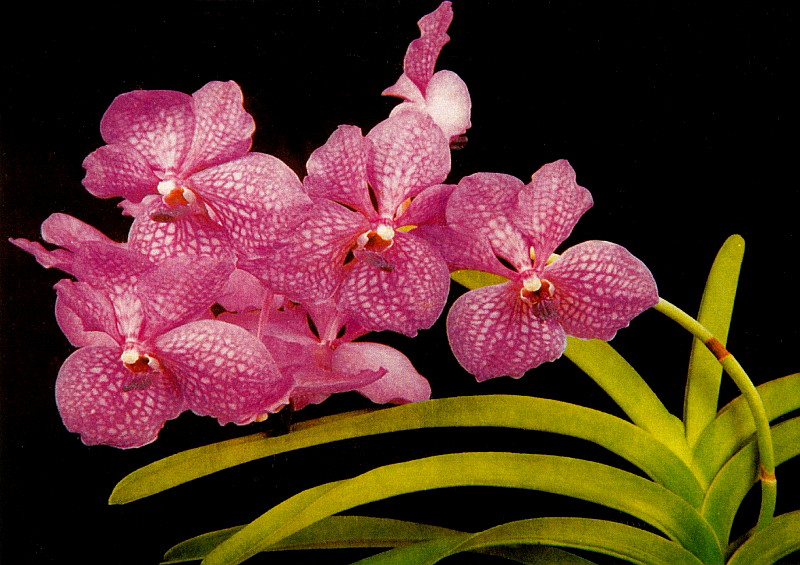
Vanda Rothschildiana, named in honour of
Walter Rothschild
It is certain that Walter Rothschild could not have achieved his
success without the expertise of Arthur Dye, the head gardener at
Tring Park (see Chapter 5). Arthur’s
skill was acknowledged when in 1906 he was appointed to the
prestigious Orchids Committee of the RHS, where he served for thirty
years. During the Edwardian period, many medals were awarded
by the Society for specimens grown at Tring, these usually being
presented to Walter, as it was then the custom to give the owner
credit for cultivation. However, two were won by Arthur Dye in
his own right – the Silver Lindley
Medal for a specimen he had tended for thirty years, and the
Silver-gilt Lindley Medal for Gloriosa Rothschildiana, in
recognition of his distinction in introducing this plant to
horticulture. Also known as the Flame Lily, this
magnificent red and gold climber is now grown in many parts of the
world, particularly in botanical gardens. Arthur was assisted
in his work by Robert Warrior, a young Yorkshireman recruited by
Walter for his specialist knowledge of orchid-growing. When he
married a local girl, Robert gave up his gardening career in favour
of running her father’s bakery business in Akeman Street.
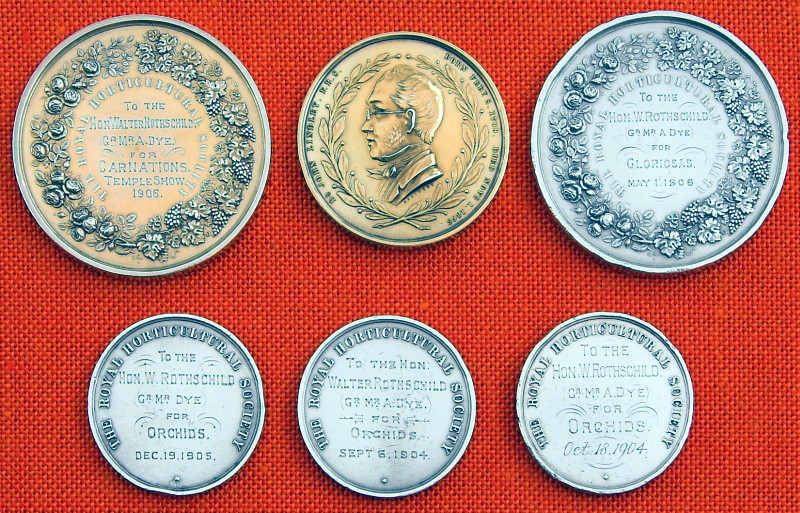
RHS medals awarded for plants cultivated by Arthur
Dye
In 1907 Walter Rothschild was again honoured by the RHS with the
award of a Silver Banksian Medal for an especially fine specimen of
the Australian Giant Lily, Doryanthis Excelsa. Rarely
seen in England, this spectacular exhibit was over ten feet in
height, and bore a splendid flower. Other exotic plants were
also grown under glass at Tring Park, and one house was
devoted entirely to the Amaryllis collection. In another house
were the Croton, Caladium, Alocasias, Dracænas, as well as varieties
of the Coleus.
Charles Rothschild, like his brother, had a passion for orchids.
When he established his own home, Aston Wold in
Northamptonshire, he chose some of the rarer species from the 2,000
at Tring to take to his hothouses: he also appointed a head gardener
trained by Arthur Dye. This enabled him to present to his
father on his 70th birthday a pure white Cattleya, which at
the time was considered a miracle. On a later collecting trip
to Lake Victoria, Charles brought home the corms and seeds of the
blue Water Lily. To cultivate these, he built a special
greenhouse at Aston Wold where they grew to an enormous size,
and it was these flowers that were strewn on Walter Rothschild’s
coffin on its final journey from Tring to Willesden Jewish Cemetery.
Another enthusiastic grower of foreign plants was Jan Stevens, a
distinguished literary critic. A native of South Africa, he
was sent to England to be educated after his mother drowned.
In the 1950s he bought Chapel End Farm at Wilstone, together
with the adjoining Church Field. The beautiful house, parts of
which date to Tudor times, had a large conservatory where Jan grew
exotic plants, many from abroad. His London connections and
dealings with Kew Gardens ensured that the opening ceremony of the
village annual horticultural show was usually performed by
interesting personalities including, in 1954, the actor Donald
Sinden.
As the twentieth century progressed, opportunities for individuals
to pursue unusual gardening passions dwindled, and vast hothouses in
private gardens have become a thing of the past. But most of
us are fascinated by foreign plants and, as an afterthought, how
many of us at some time in our lives have planted an orange or lemon
pip in a flowerpot to see if it will take root and grow into a
little tree?
――――♦――――
CHAPTER 11
SCHOOL GARDENS
|
For, long ago, the truth to say,
He has grown up and gone away
And it is but a child of air
That lingers in the garden there.
Robert Louis Stevenson
(1850-1894) |
During World War I certain compulsory measures, strongly supported
by the Prime Minister, were introduced to help the war effort.
It was apparent then that national food shortages would continue for
some time after the conflict was over, and so it was considered
essential that schools should maintain their own garden areas.
As early as 1914 the County Schools’ Gardening Instructor had
arrived in Tring to urge the Headmaster to include gardening on the
timetable.
A fertile plot near the centre of the town could not be found and,
despite spasmodic attempts to locate a suitable area, it was not
until four years later that the subject of Gardening was introduced
at Tring School. The project had inauspicious beginnings, for
in the first week one boy was rushed to hospital with a fork through
his foot.
This gardening plot was sold for building land, but a second site
was found off Dundale Road. County Advisers continued to pay
regular visits offering advice on the growing of potatoes and other
vegetables. Mr Dawe, the Instructor, took each class for half
a day every week but seemed to find his duties taxing, as the school
log-book records that sometimes Mr Dawe was too tired to turn up.
He was succeeded by Ernest Gilbert who, until joining the army in
1916, had been head gardener at Champneys.
Matters then settled down and gardening became very much an accepted
part of the school curriculum, and it remained an important subject
for forty years. The next headmaster took a particular
interest in gardening activities, and appointed the school
caretaker, Ted Brittain, as garden instructor. In his book,
thoroughness was everything, and any pupil who upset him by being
‘too smart’ was always given the hard task of double-digging.
However, Ted’s efforts paid off, and the School entered a display of
vegetables at the Watford & Home Counties Horticultural Society,
which was judged good enough to be awarded the Lady Salisbury
Challenge Shield.
Some villages also had school gardens, and those at Wigginton were
in Hemp Lane. Visits from inspectors were a regular
occurrence, and advice was given on pruning and setting plants.
The oldest children had their own little areas to look after, and
competition for the best kept plot was keen. Training was
given in the care of tools, which had to be cleaned after use,
smeared with oil, and hung up in their correct place. A
thermometer and rain-gauge hung outside, and one pupil was assigned
to record the readings.
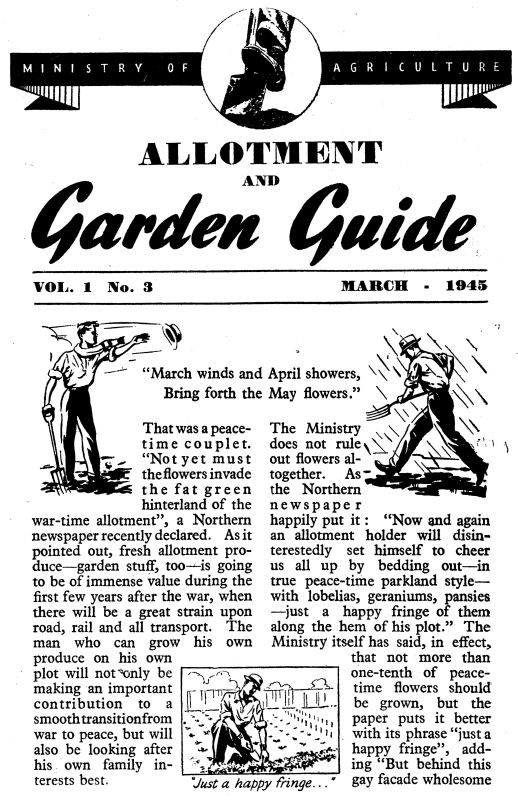
The importance of the School garden was again realised in the second
war, when gardening periods on the timetable were doubled during the
potato harvest. The School made its own contribution
throughout the period of the Dig for Victory campaign.
In the summer holiday of 1942 it was suggested that the school
should remain open for pupils who wanted to tend the garden, but it
is not recorded whether any were sufficiently interested.
During the London blitz, children evacuated to Tring were encouraged
by their teachers to grow vegetables on special allotment areas
allocated by the Council. Things did not always go well for
them, as the local paper reports that thefts of produce often
occurred during the night.
By this time, the School garden was located on a plot in the grounds
of Hawkwell House in Station Road, but a new teacher of Rural
Science decided to improve the children’s knowledge of gardening.
Soon his enthusiasm led the young horticulturists to develop a
viable small holding at Mortimer Hill. The vegetables and
fruit grown were sold cheaply to pupils.
As the years went by, teaching demands changed and as time could not
be found to maintain the fruit trees and bushes, the area eventually
disappeared beneath asphalt to become the school’s tennis courts.
In modern times various gardens have been created at Tring schools,
but these days the purpose is not for economic reasons, but directed
at learning and play. A good example is at Grove Road Primary
School where the children have been encouraged to help to keep the
garden area tidy by clearing weeds and leaves. Pupils no
longer have to undertake double-digging under the stern eye of a
garden instructor, but instead plant hundreds of bulbs and various
types of herbs.
――――♦――――
CHAPTER 12
MEMORIAL GARDENS
|
There’s Rosemary, that’s for remembrance;
Pray you, love, remember:
And there is Pansies, that’s for thoughts.
William Shakespeare |
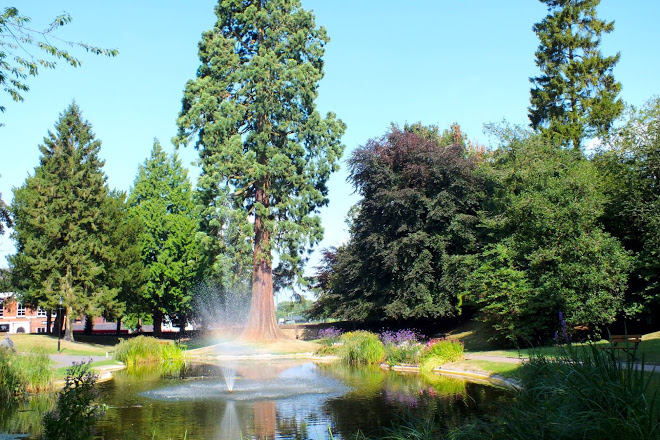
Tring Memorial Gardens
In March 1947 a questionnaire was circulated in the town to canvass
opinion about how best to honour Tring’s war dead. The outcome
was 107 votes for a sports centre, 67 for improvements to the
Victoria Hall, and 180 for a public garden with a paddling pool.
Possibly the absence of a definite project led to a disappointing
and rather shameful response to the accompanying appeal for funds.
The Council decided that the paltry sum collected of £20 6s.2d.
could only finance the addition of names of the fallen to be added
to the existing memorial in front of the parish church.
Disquiet over this outcome led Tring to wake up, and three months
later a public meeting was held and a committee of twelve members
elected to launch a firm appeal with the target of raising £5,000.
The stated objective of the scheme was to provide a fitting memorial
(other than a monument) to those who had fallen in World War II, as
well as a thanksgiving for those who had returned home safely.
Considerable interest was taken in this new appeal fund, and a
well-known Tring shopkeeper came up with a novel idea to start the
ball rolling. He suggested that businessmen should give £1 for
every year they had been trading in the town. On this basis,
his own welcome contribution amounted to £25, and others soon
followed his example. The committee again invited suggestions
as to the form the memorial should take. Among the ideas put
forward was a swimming pool, but the Council considered the running
costs would be too great. Eventually, and after much debate,
it was decided to create a Garden of Remembrance in the old water
garden of the Tring Park estate.
This area had been created in the 1890s when several properties in
the Lower High Street were demolished. These included Rose
Cottage, once the home of a Tring solicitor, and the Green
Man, an early-Victorian pub. A large irregular-shaped lake
was dug out and planted with different species of water-lily, and
the whole surrounded by abundant picturesque planting. The
entire garden was hidden from view from the main road by a high
brick wall and a thick screen of trees and shrubs.
After the second world war, the lake and its surroundings presented
a sorry sight. For years, the area had suffered almost total
neglect and had become overgrown, dark, and depressing. Any
idea that the water garden could revert to its former glory was
clearly impossible, for it was realised that the number of gardeners
required for its maintenance would never again be available in the
modern world. Instead it was thought that clearance of the
area, resurfacing the lake bed, and some simple replanting would
offer an acceptable and pleasing aspect as a public open space.
Even so, nothing happened swiftly. Three years passed before
the legal process of transferring the site to Council ownership was
settled, and thereafter work proceeded slowly. It was another
three years before the garden was formally opened in June 1953, an
event planned to coincide with the Coronation of Elizabeth II.
Over 200 people were present at the unveiling ceremony and
dedication service conducted by the Reverend Lowdell, Vicar of
Tring.
The garden was enjoyed for some years before it fell victim to
mindless vandalism, but when Mrs Westron, widow of nurseryman Frank
Westron (see Chapter 3) died in 1971 she
bequeathed £50 to be spent on the Memorial Garden. The Council
then decided to use this sum towards repairing the damage.
Today the lake looks very different from how it was in the time of
the Rothschilds. All the vegetation surrounding the perimeter
has been cleared, allowing an uninterrupted view of the magnificent
Wellingtonia that towers over the northern end. In
recent years some alterations have taken place, following criticism
that the approach to the gardens was dark and uninviting. The
Council then organised contractors to thin trees and shrubs
bordering the entrance pathway, allowing more daylight through to
provide a welcoming aspect. In 2001 the lake had to be drained
and the fish evacuated when it was necessary to investigate the
cause of serious water seepage. A bad crack in the concrete
base was discovered, repaired, and four carp returned to the water
following their sojourn at a nearby fish farm.
Members of the Tring branch of the British Legion attended a
reopening ceremony, and presented a plaque listing the names of
those men from the town killed in World War II. This is
mounted on the brick gate-pillar at the entrance to the garden.
――――♦――――
From CRAIGCROOK CASTLE
by Gerald Massey
(‘The Tring Poet’ 1828-1905)
|
The breath of Dawn brought God’s good-morning kiss
To bud and leaf and flower, and human hearts
That like pond-lilies open heavenward eyes.
Sweet Lilies-of-the-Valley, tremulous fair,
Peep through their curtains clasped with diamond dew.
The Pansies, pretty little puritans,
Come peering up with merry eyes to see,
And arch Laburnum droops her budding gold
From emerald fingers, with such taking grace.
The Lilac is alight with all her stars:
Wall-flowers in fragrance burn themselves away
With the sweet season of her precious pyre;
Pure passionate aromas of the Rose,
And purple perfume of the Hyacinth,
Come like a colour thro’ the golden day.
A summer soul is in the Limes; they stand
Low murmuring honeyed things that wing forth bees;
Their busy whisperings done, the Poplars hush!
And toss their locks in frolic wantonness.
Deep after deep the generous heart of Spring,
Full of glad days, hath opened into bloom,
Ripe with all sweetness.
――――♦――――
SOURCES:
|
Tring Horticultural Society archives
Dacorum Heritage Store
Bucks Herald archives
Berkhamsted Gazette archives
Gardens of West Hertfordshire, Tom
Williamson, 2000
The Gardeners’ Chronicle, July 1885
Country Life, September 1993
The Rothschild Gardens, Miriam
Rothschild, 1996
Dear Lord Rothschild, Miriam
Rothschild, 1983
Royal Horticultural Society records
Notes written by the late Bob Poland
The Life of Mrs Humphry Ward, Janet
Trevelyan, 1923
That Tring Air, Arthur Macdonald,
1940
History of Tring, Sheila Richards,
1974
The History of Tring School, Clifford
L. Watkins, 1993
Country Women at War, Ruth Lady
Craufurd, 1971
A Wiggo Man, Danny Hearn, 1986
Kelly’s Trade Directories, 1856 to 1936
Chamber’s Encyclopædia |
――――♦――――
|
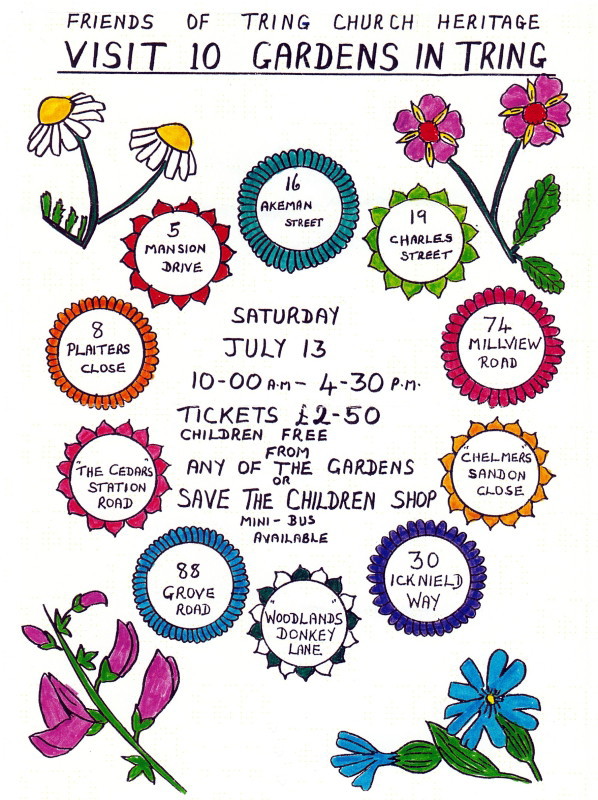
Tring Garden Open Day, 1998 |